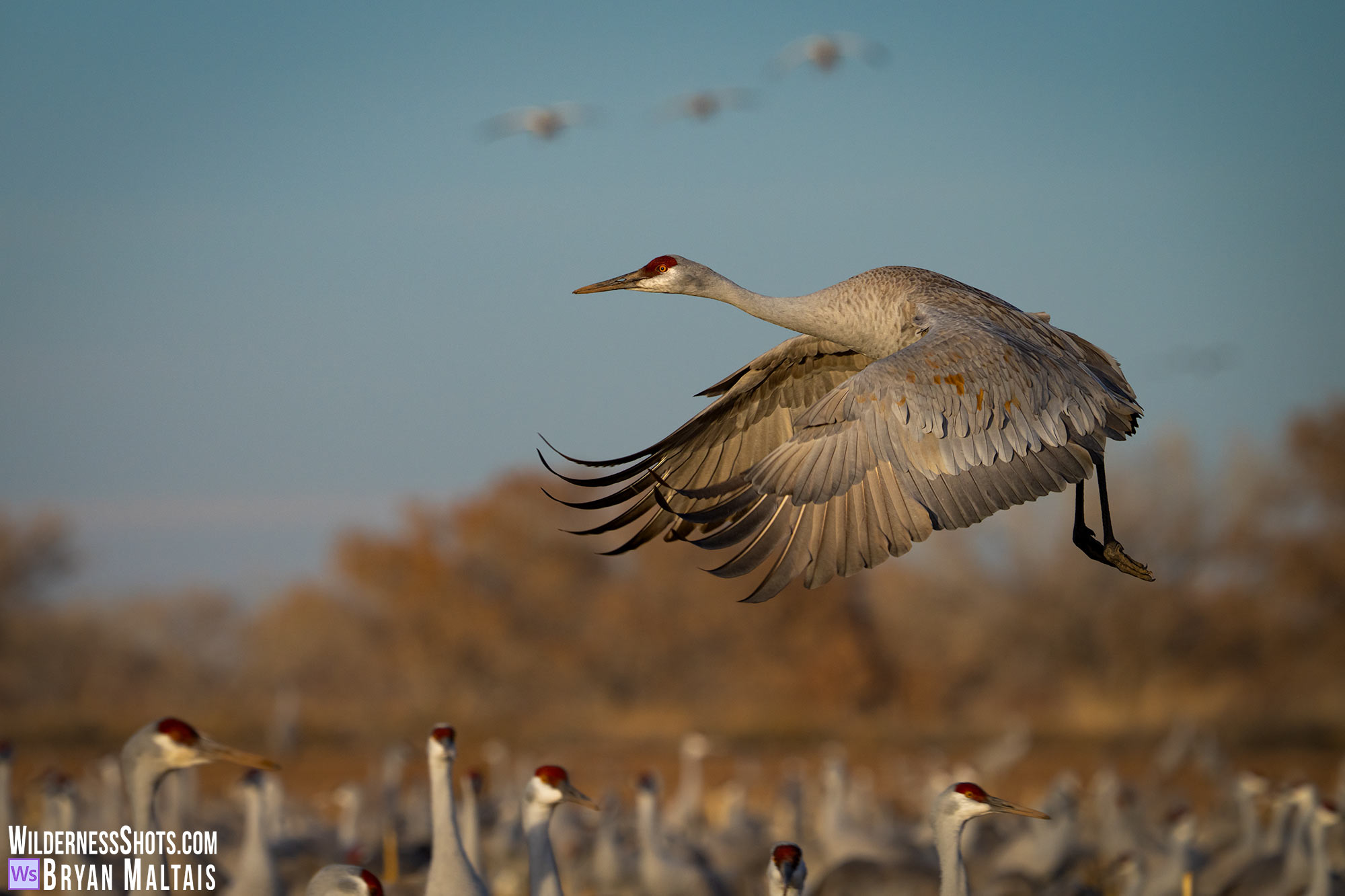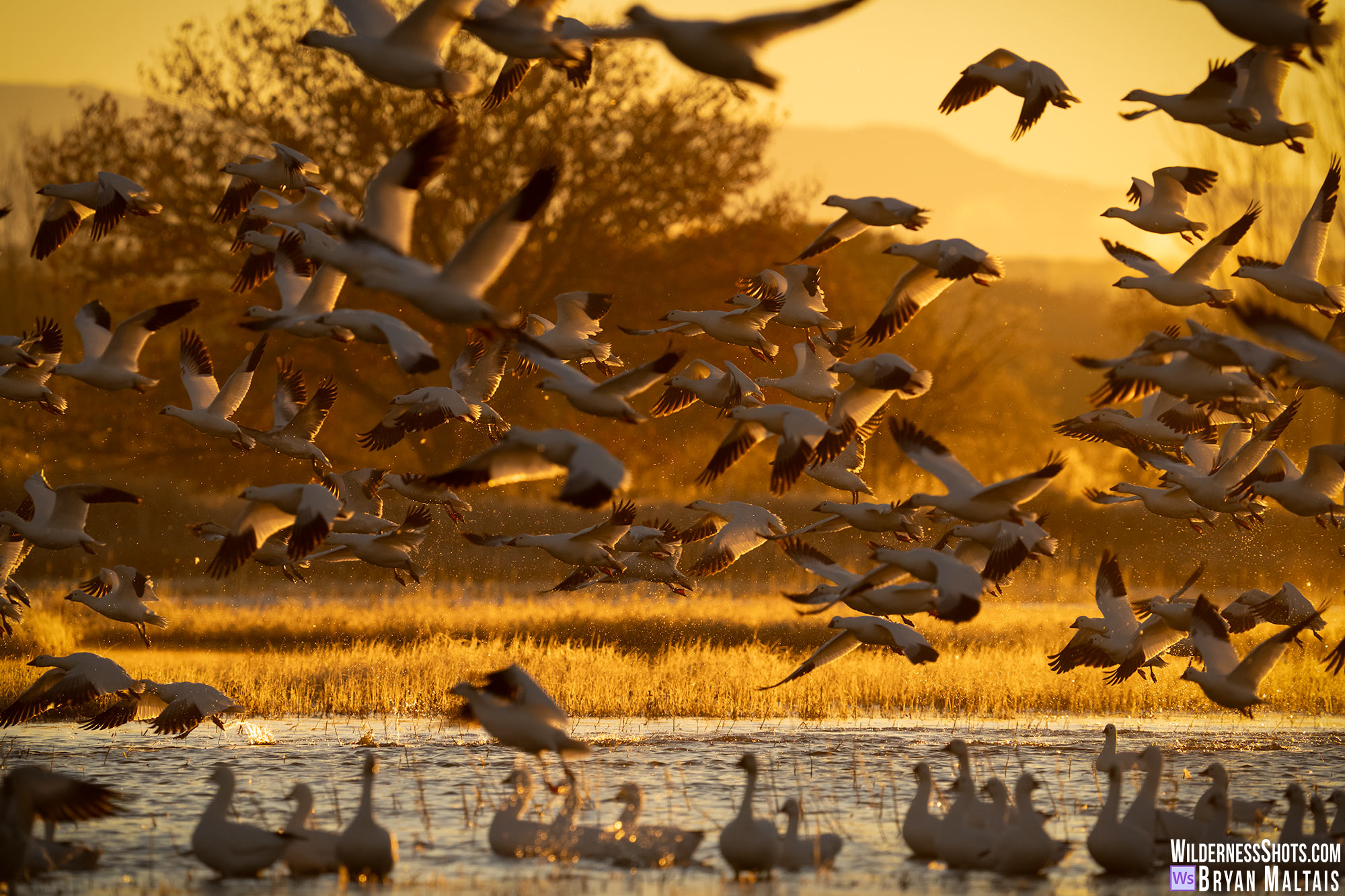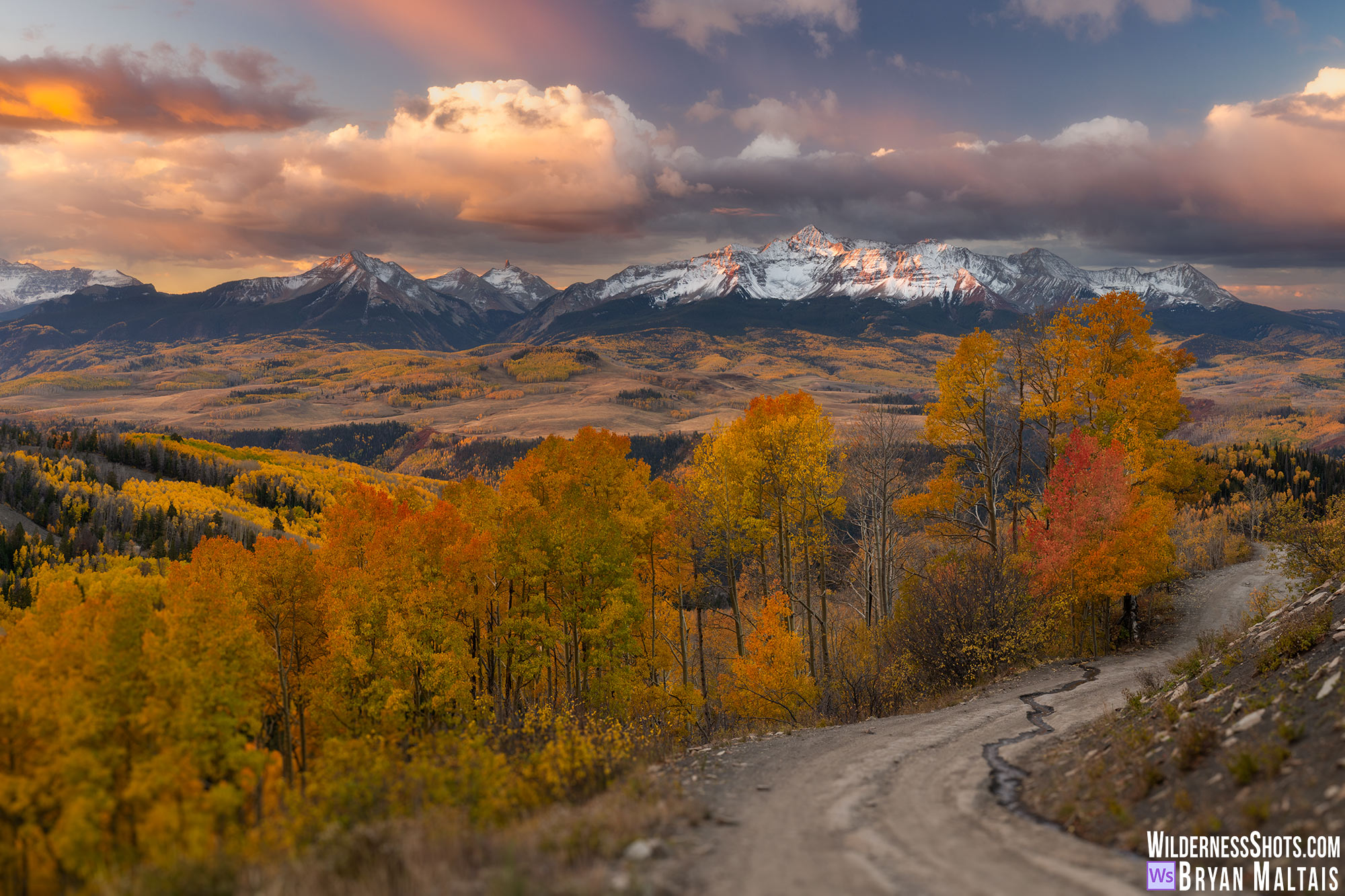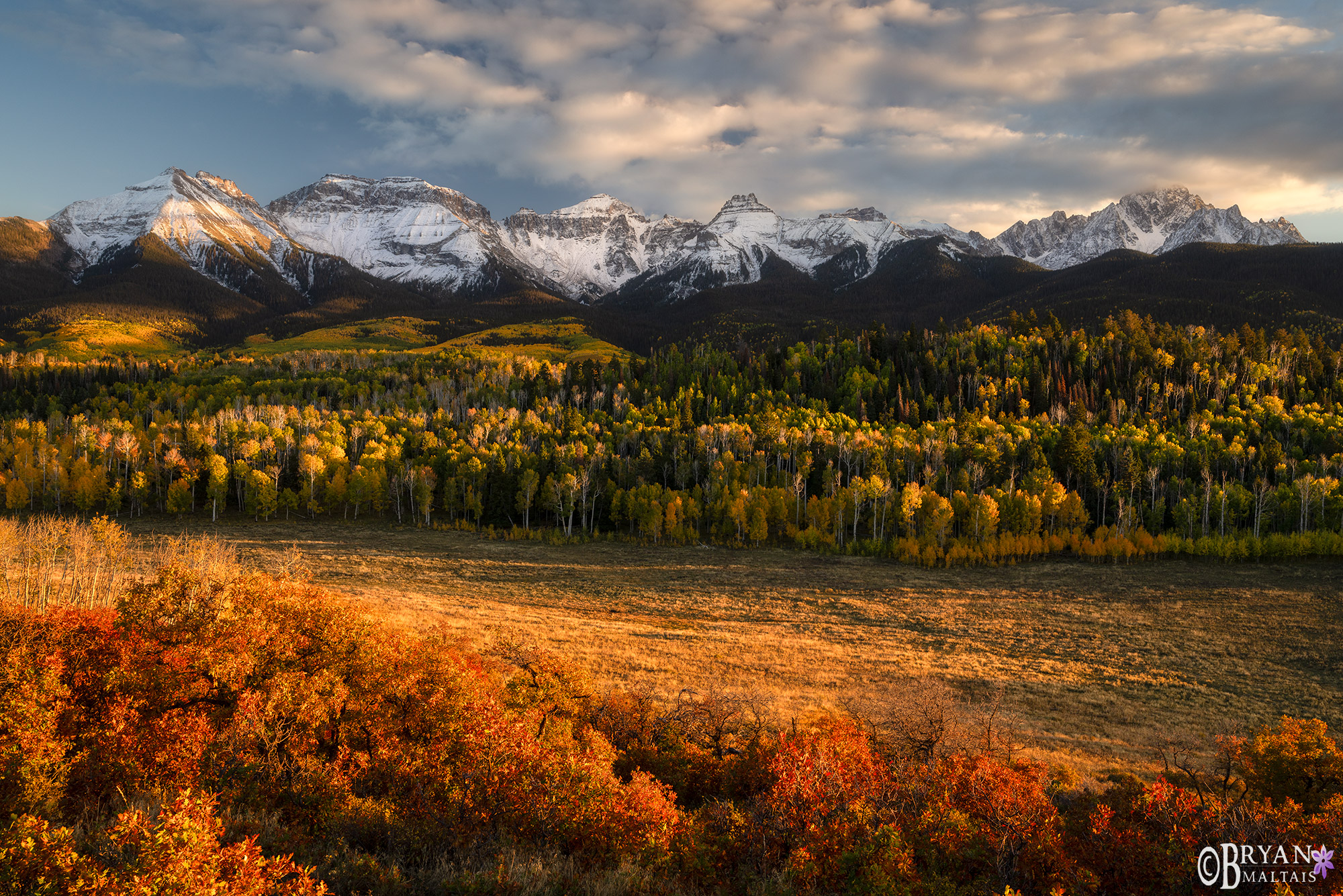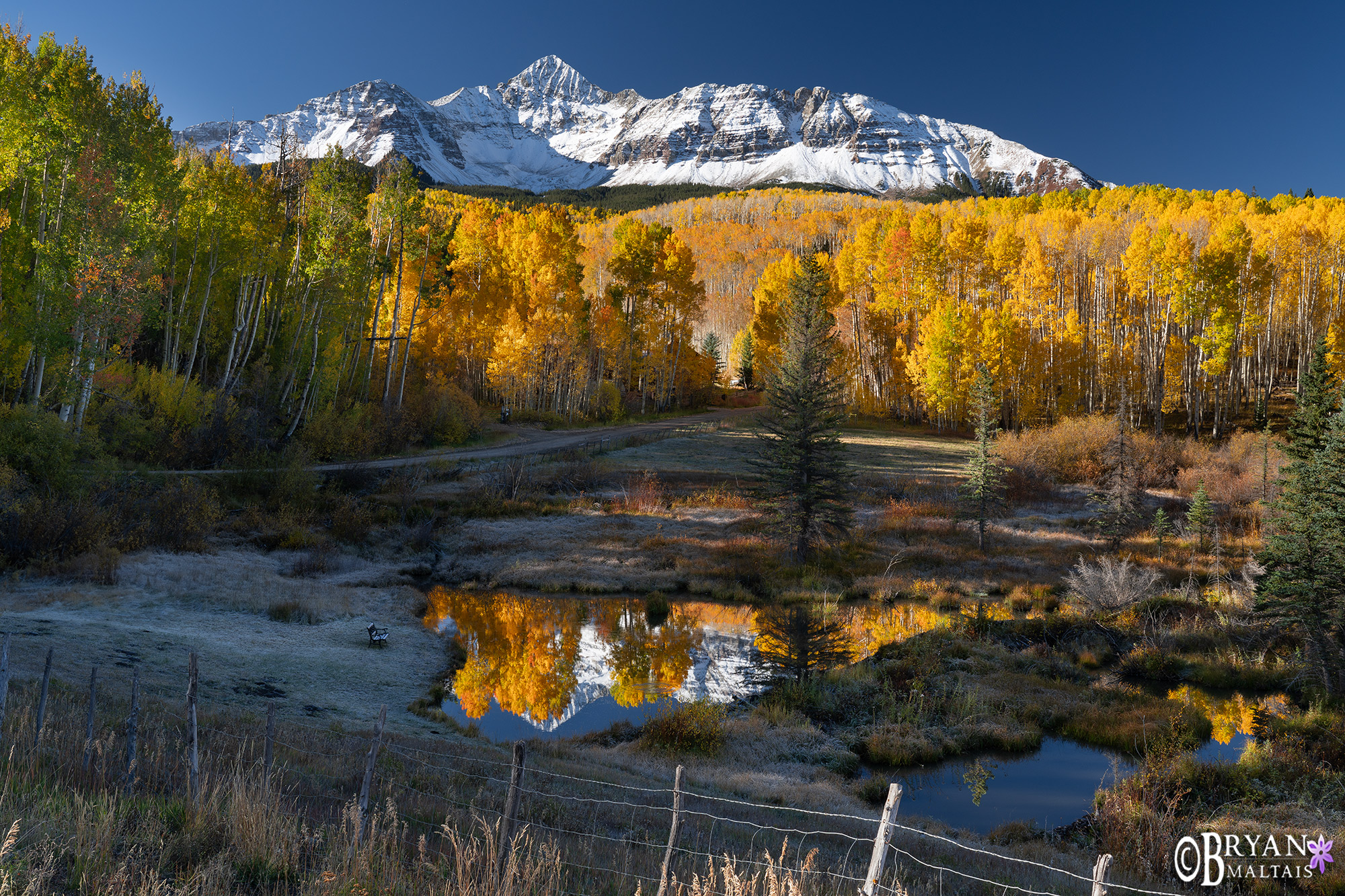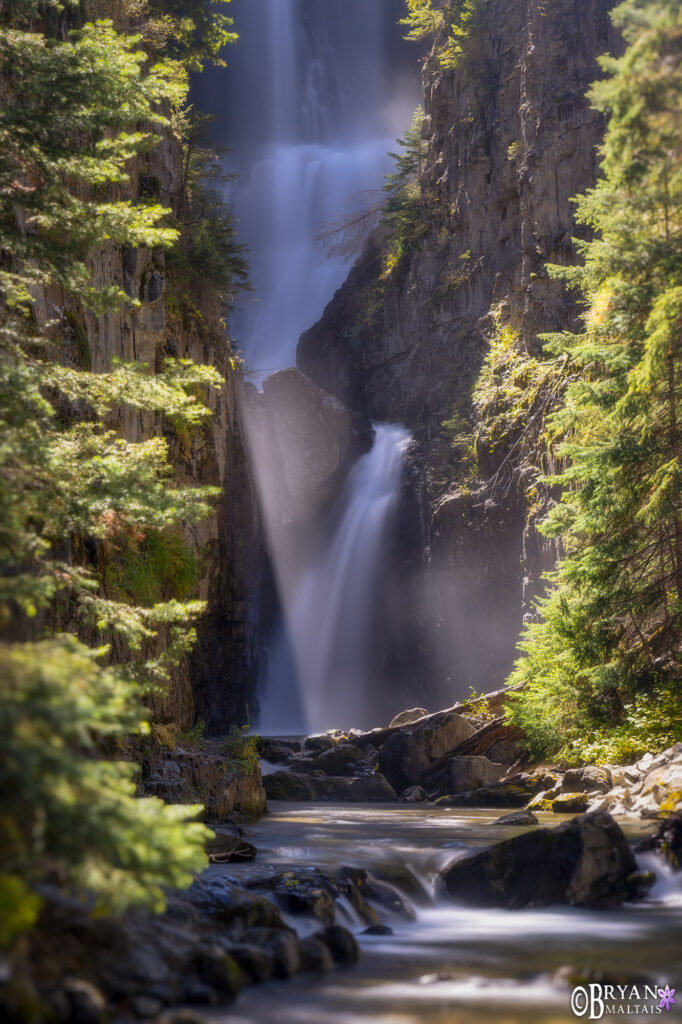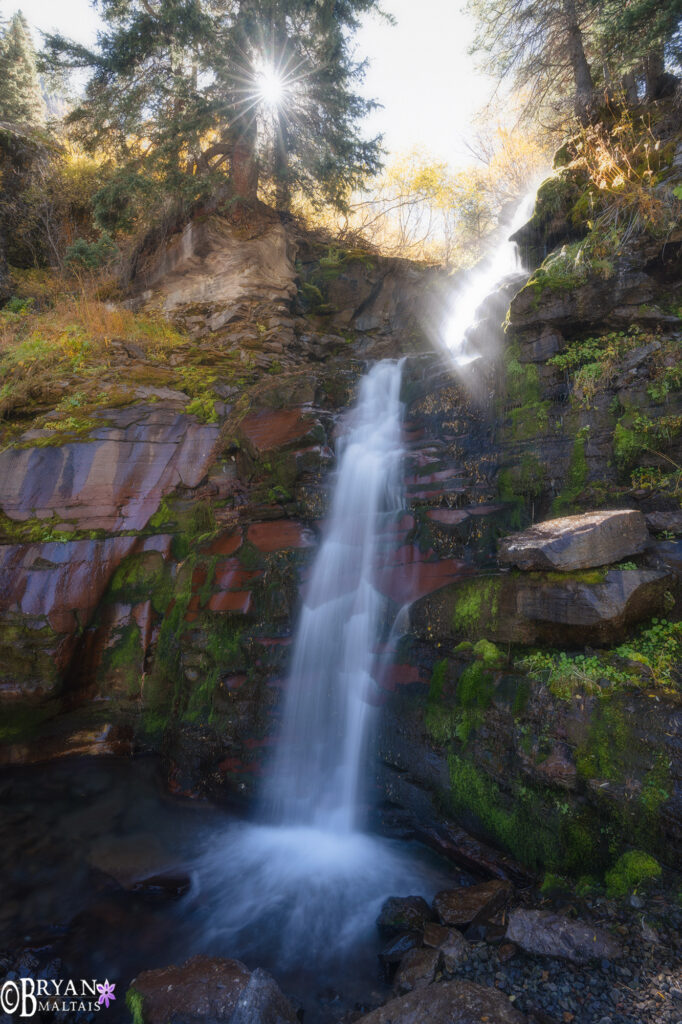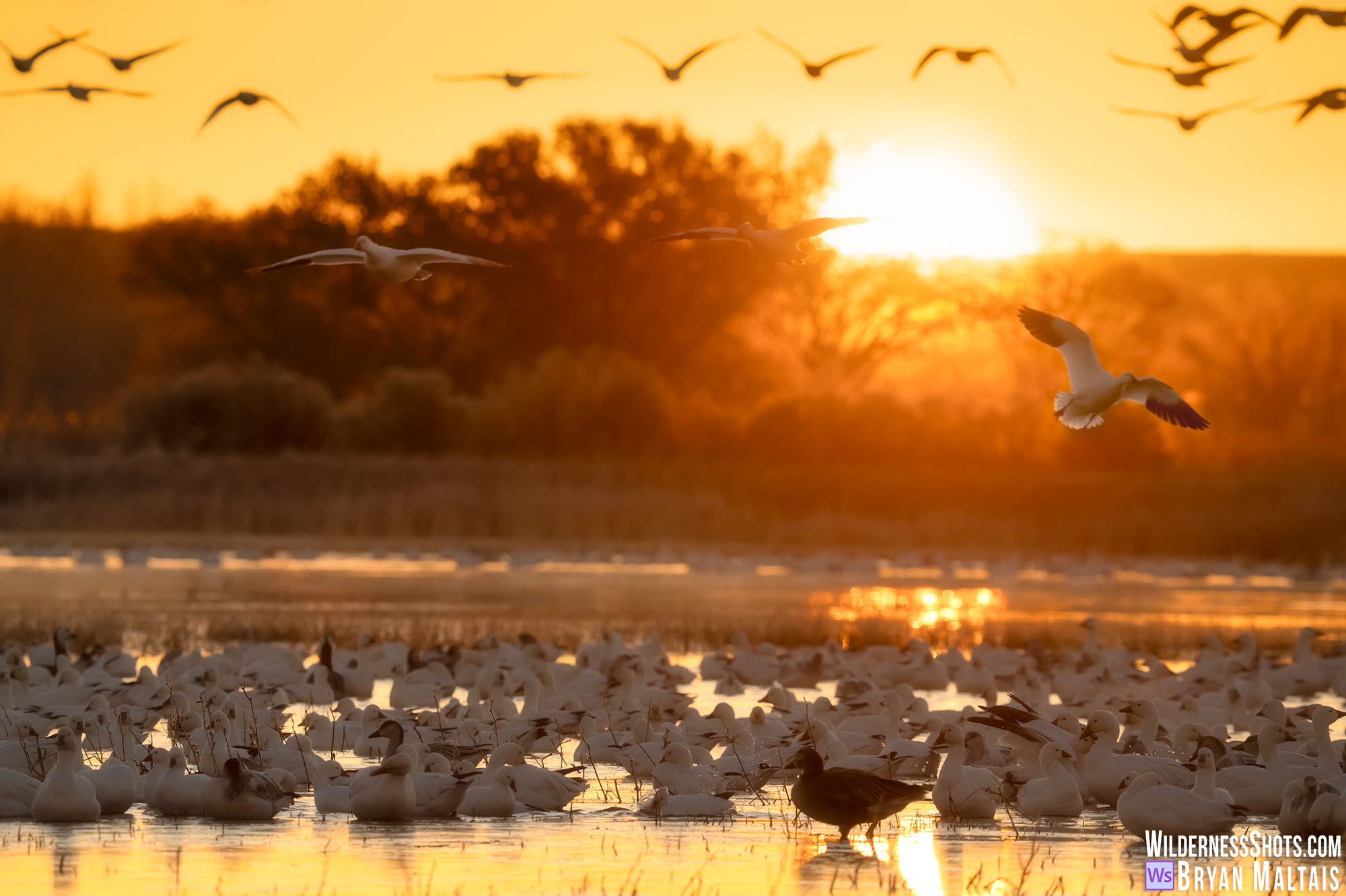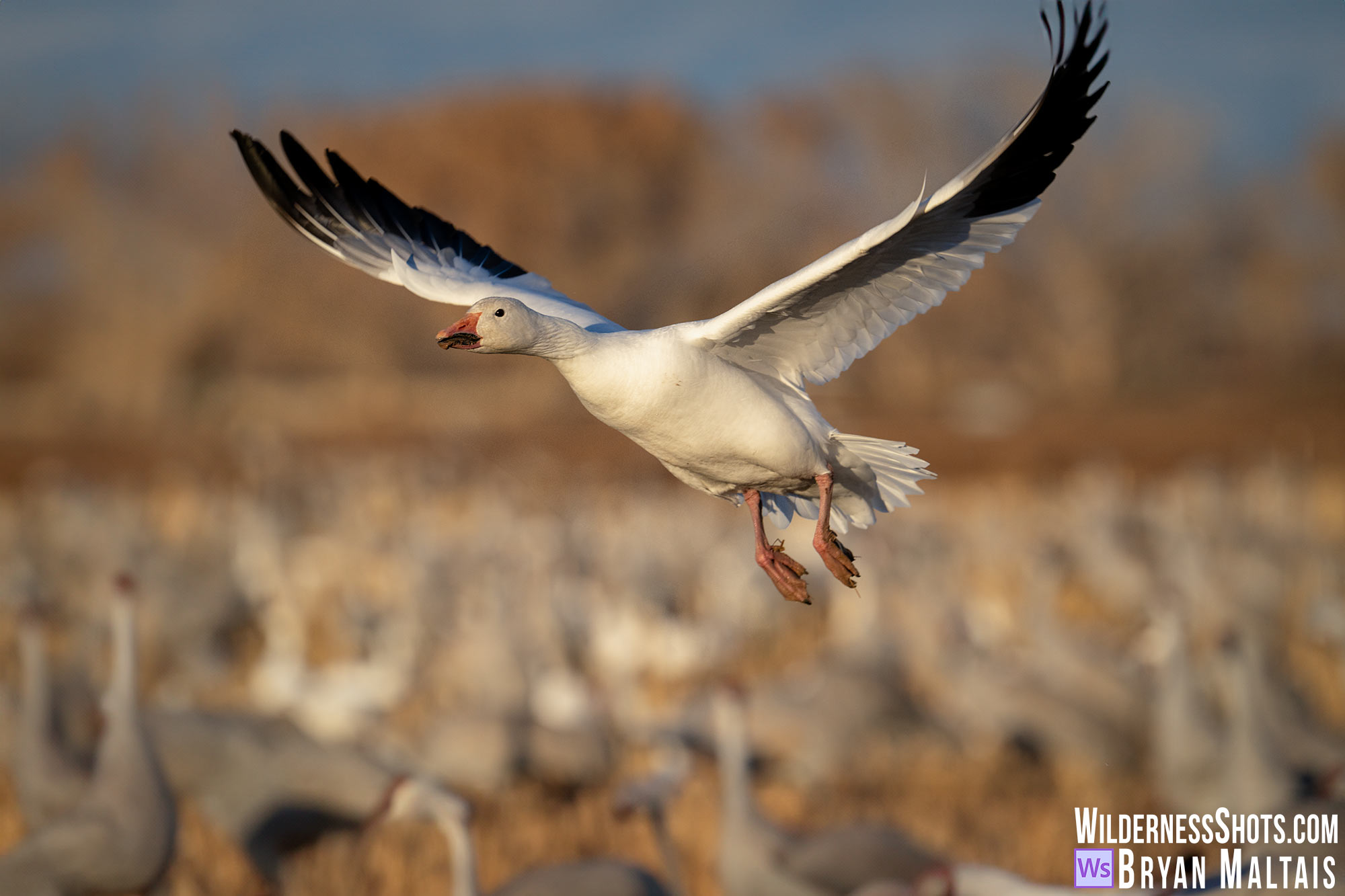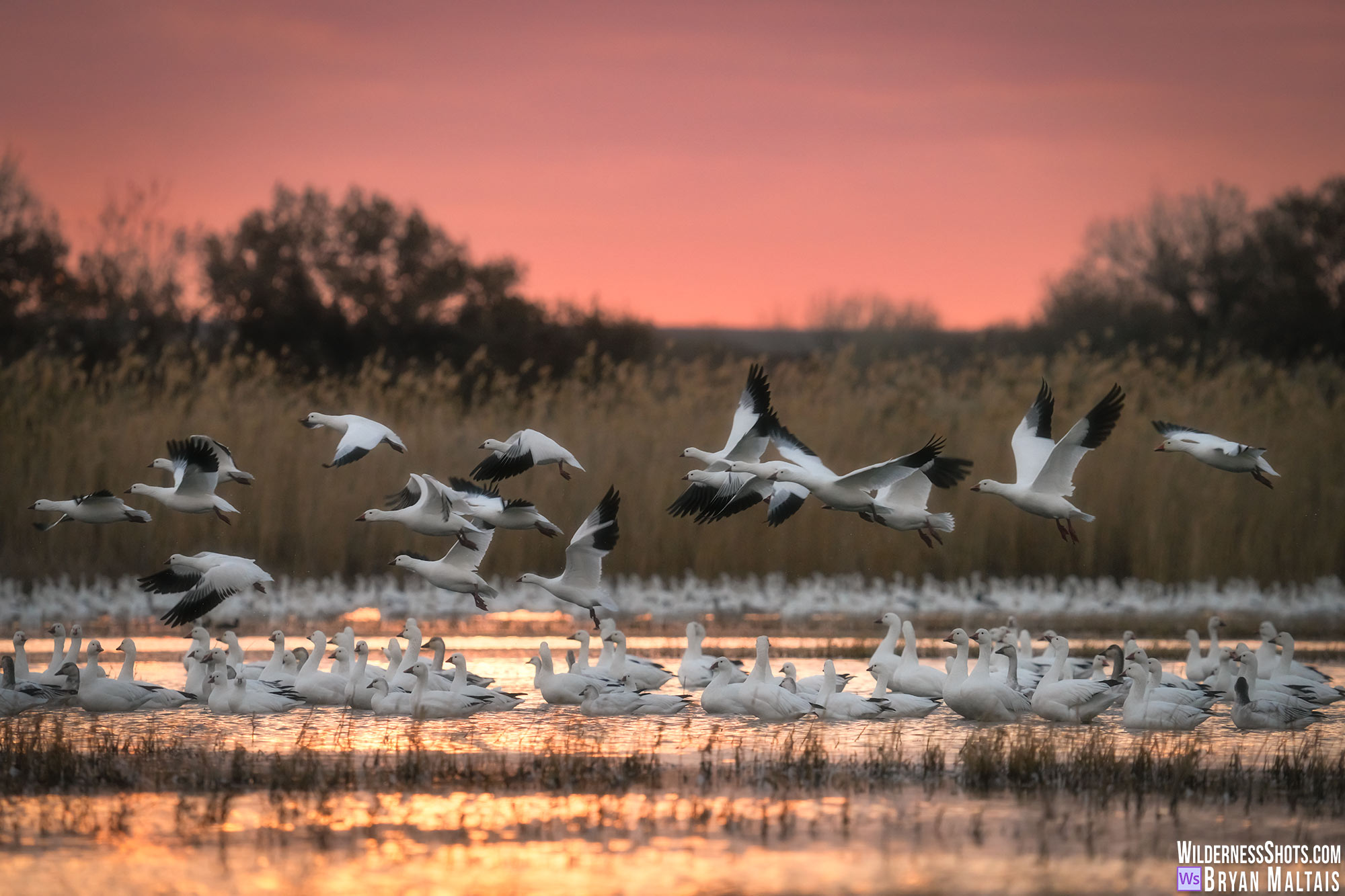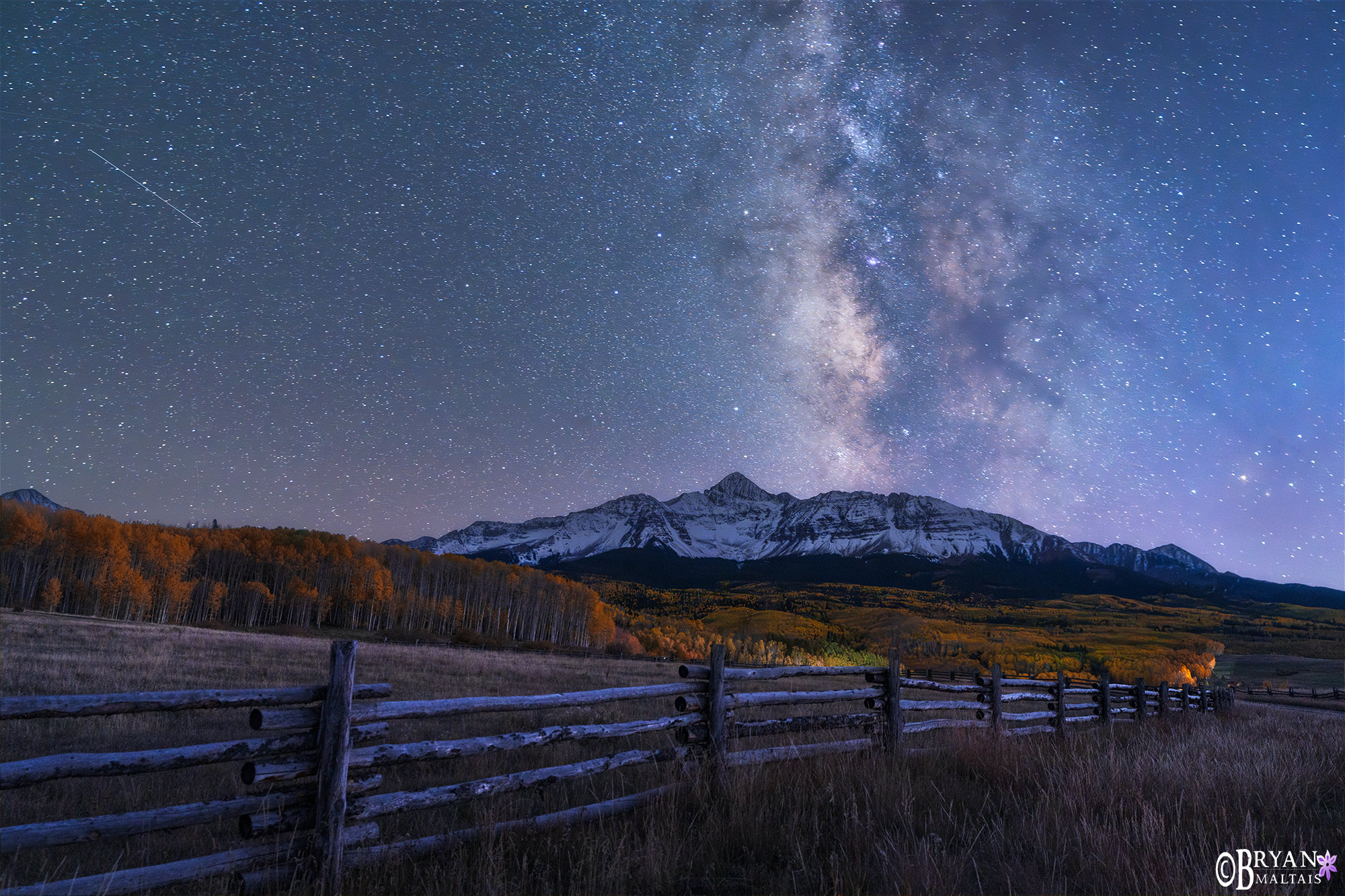
A year in Photos: 2023 in review
2023 was a blessed year that allowed me to witness and capture countless beautiful, natural phenomena. Since a picture tells a thousand words, I’ll let my photos do just that…
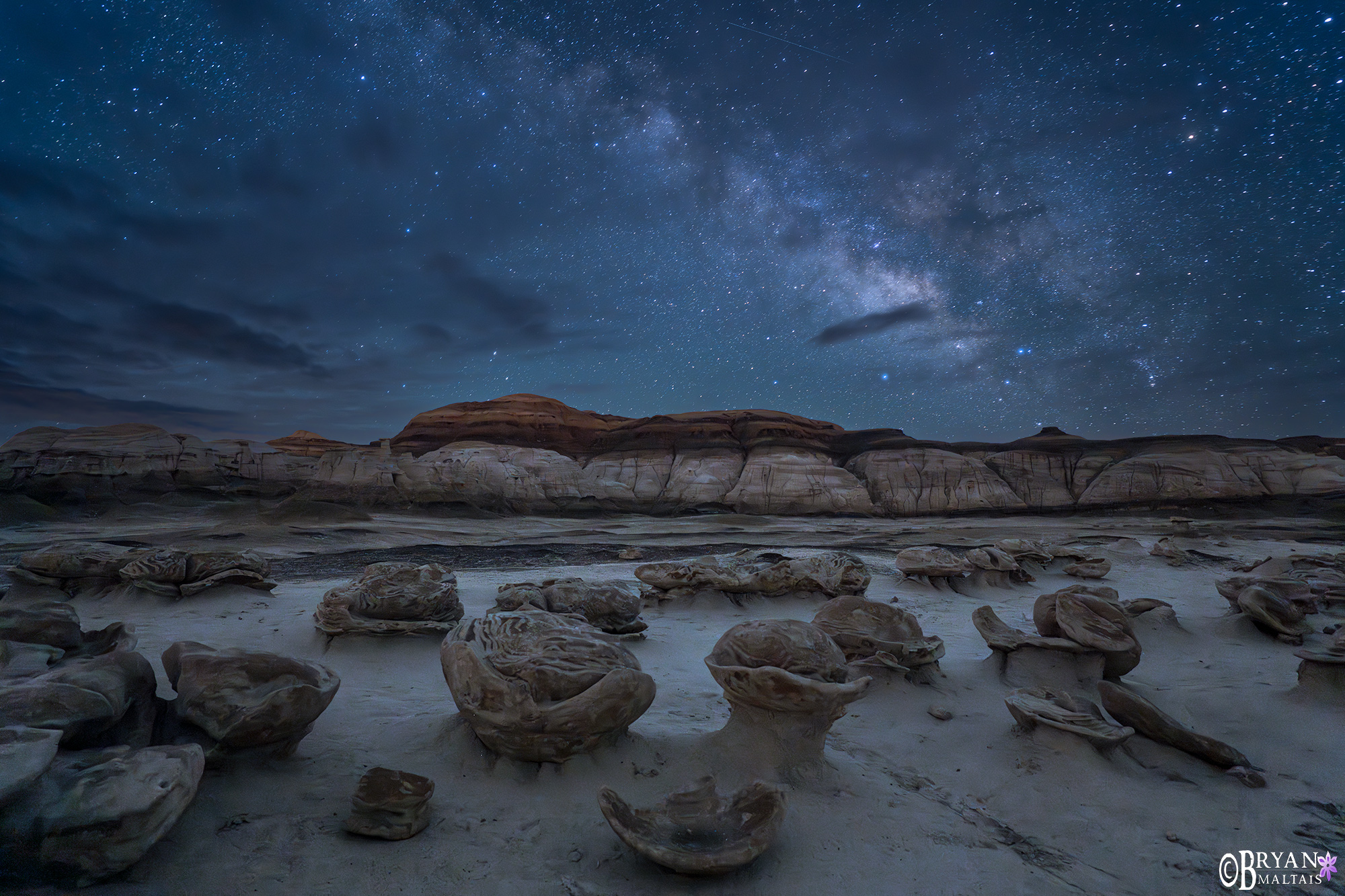 March kicks off Milky Way season in the northern hemisphere. It’s when the Galactic Core reemerges above the horizon from winter hibernation. In early spring it rises shortly before dawn, which lets you stay in place to photograph sunrise. This is the Alien Egg factory/Cracked Eggs in New Mexico’s Bisti Badlands.
March kicks off Milky Way season in the northern hemisphere. It’s when the Galactic Core reemerges above the horizon from winter hibernation. In early spring it rises shortly before dawn, which lets you stay in place to photograph sunrise. This is the Alien Egg factory/Cracked Eggs in New Mexico’s Bisti Badlands.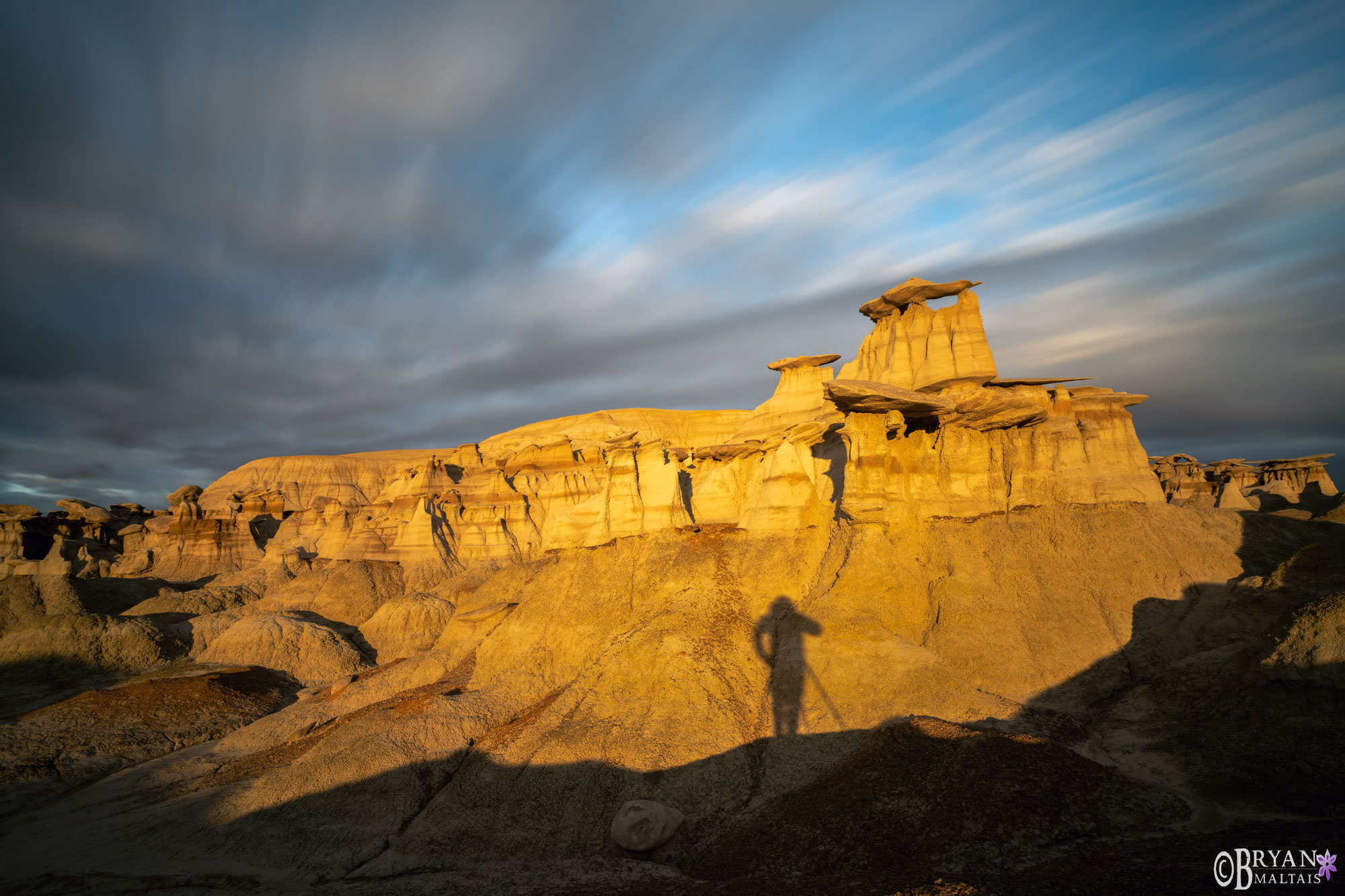 The hoodoos of Bisti Badlands, NM are a photographer’s amusement park. This is especially true at sunset where each unique mudstone formation begs for your attention during the fleeting light. At golden hour, I couldn’t get my shadow out of the low-angle light so I decided to use it to my advantage to create a self-portrait of sorts. I blurred the clouds for an abstract flavor using a 10-stop neutral density filter, which allowed a 30 second exposure.
The hoodoos of Bisti Badlands, NM are a photographer’s amusement park. This is especially true at sunset where each unique mudstone formation begs for your attention during the fleeting light. At golden hour, I couldn’t get my shadow out of the low-angle light so I decided to use it to my advantage to create a self-portrait of sorts. I blurred the clouds for an abstract flavor using a 10-stop neutral density filter, which allowed a 30 second exposure.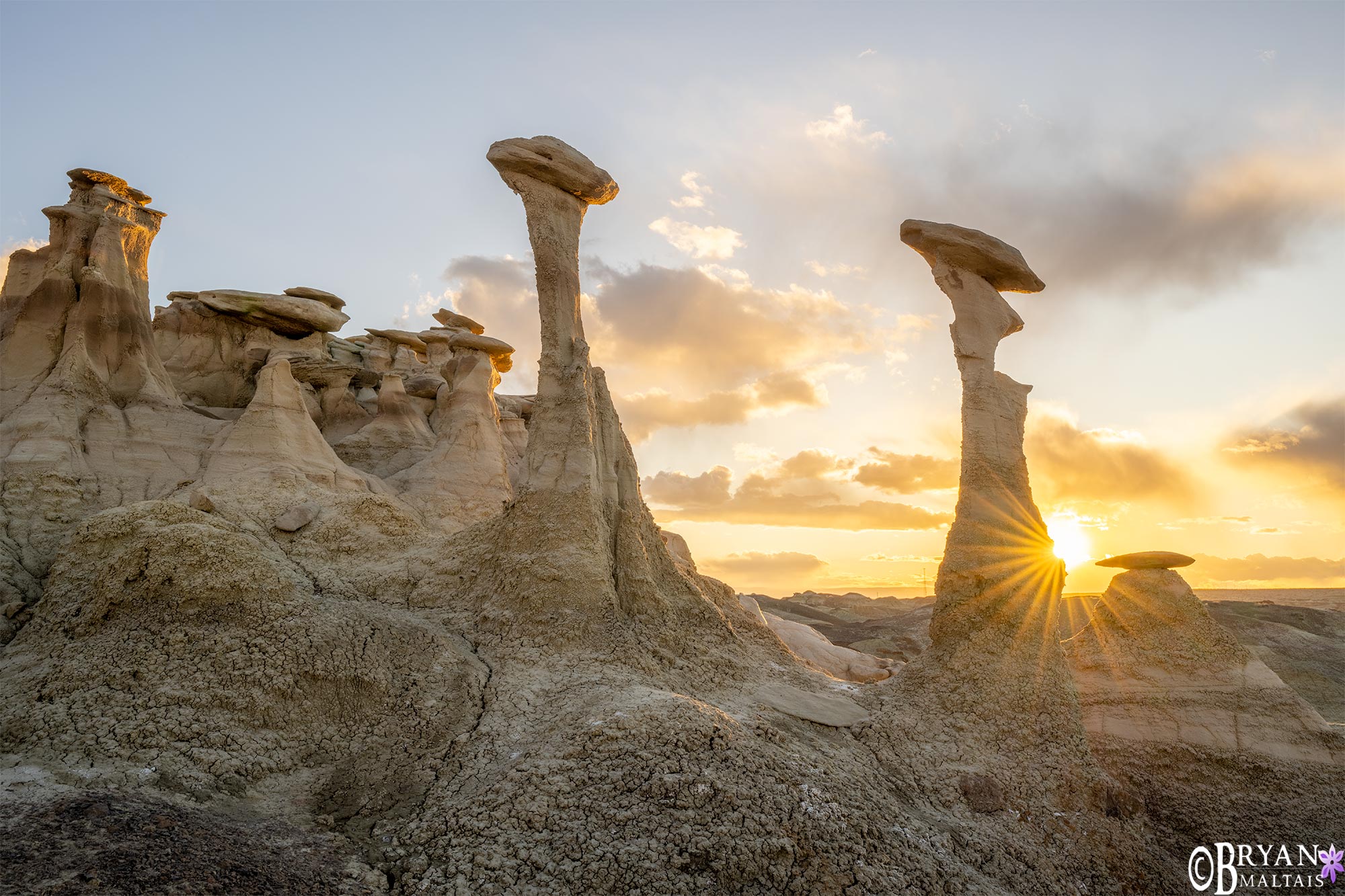
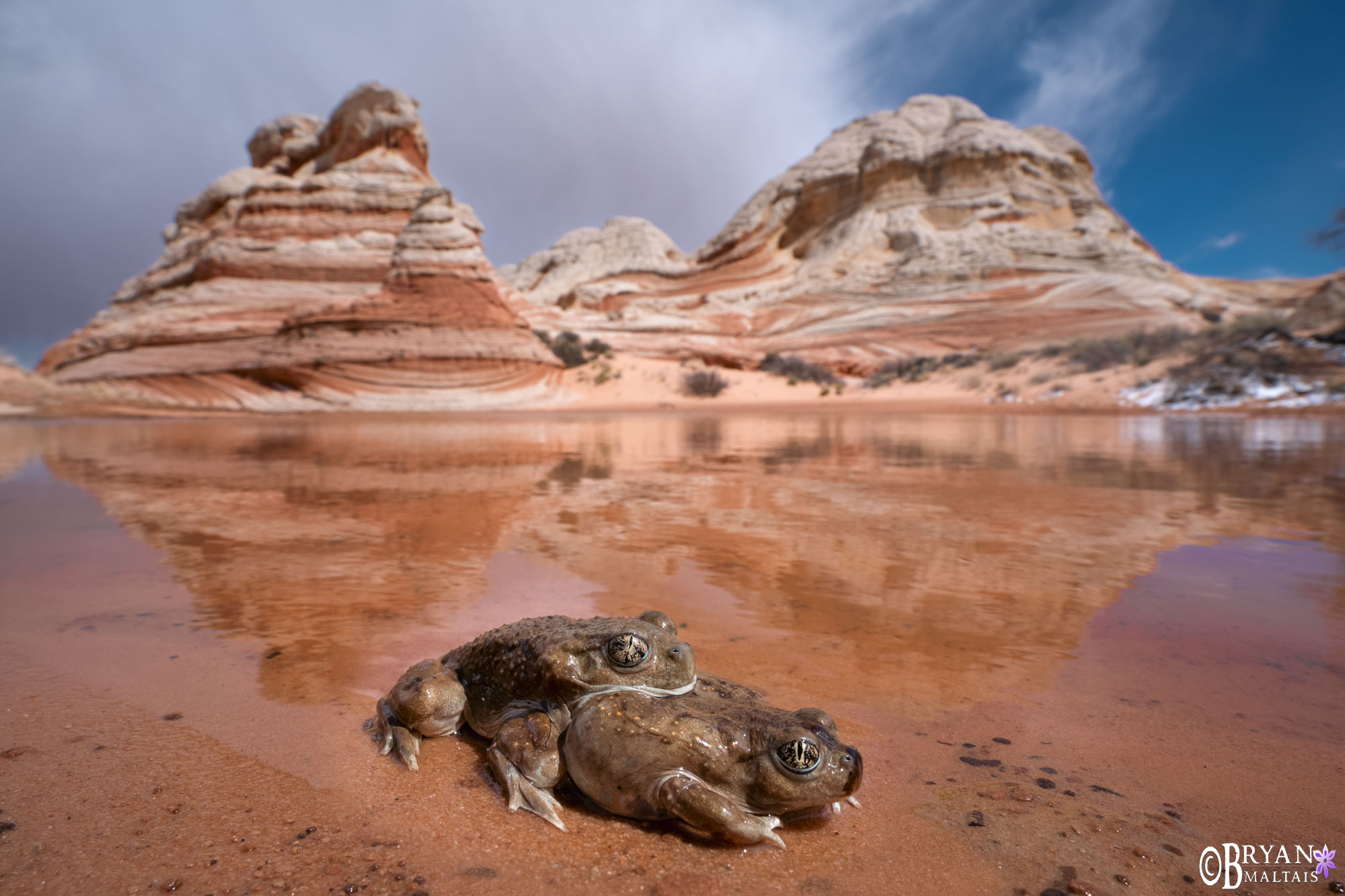 I visited Vermilion Cliffs Wilderness to photograph the alien landscape of White Pocket. I didn’t bargain on encountering amphibians mating, especially because the pool was frozen over at dawn after a morning blizzard. This vernal pool at the base of some rainbow buttes was full of egg clutches. Among the scattered clutches was this single mating pair of Great Basin Spadefoot Toads. This species is a master of extremes. In early spring when they breed, it can still dip below freezing. In summer, there’s little to no rain, and daytime highs exceed the 100’s. These little toads survive by burying themselves up to 15 ft deep in the beach-like sand. There, they lie dormant in a state of torpor for most of the year. They consume their entire year’s food during a handful of nights when they emerge during warm rains.
I visited Vermilion Cliffs Wilderness to photograph the alien landscape of White Pocket. I didn’t bargain on encountering amphibians mating, especially because the pool was frozen over at dawn after a morning blizzard. This vernal pool at the base of some rainbow buttes was full of egg clutches. Among the scattered clutches was this single mating pair of Great Basin Spadefoot Toads. This species is a master of extremes. In early spring when they breed, it can still dip below freezing. In summer, there’s little to no rain, and daytime highs exceed the 100’s. These little toads survive by burying themselves up to 15 ft deep in the beach-like sand. There, they lie dormant in a state of torpor for most of the year. They consume their entire year’s food during a handful of nights when they emerge during warm rains.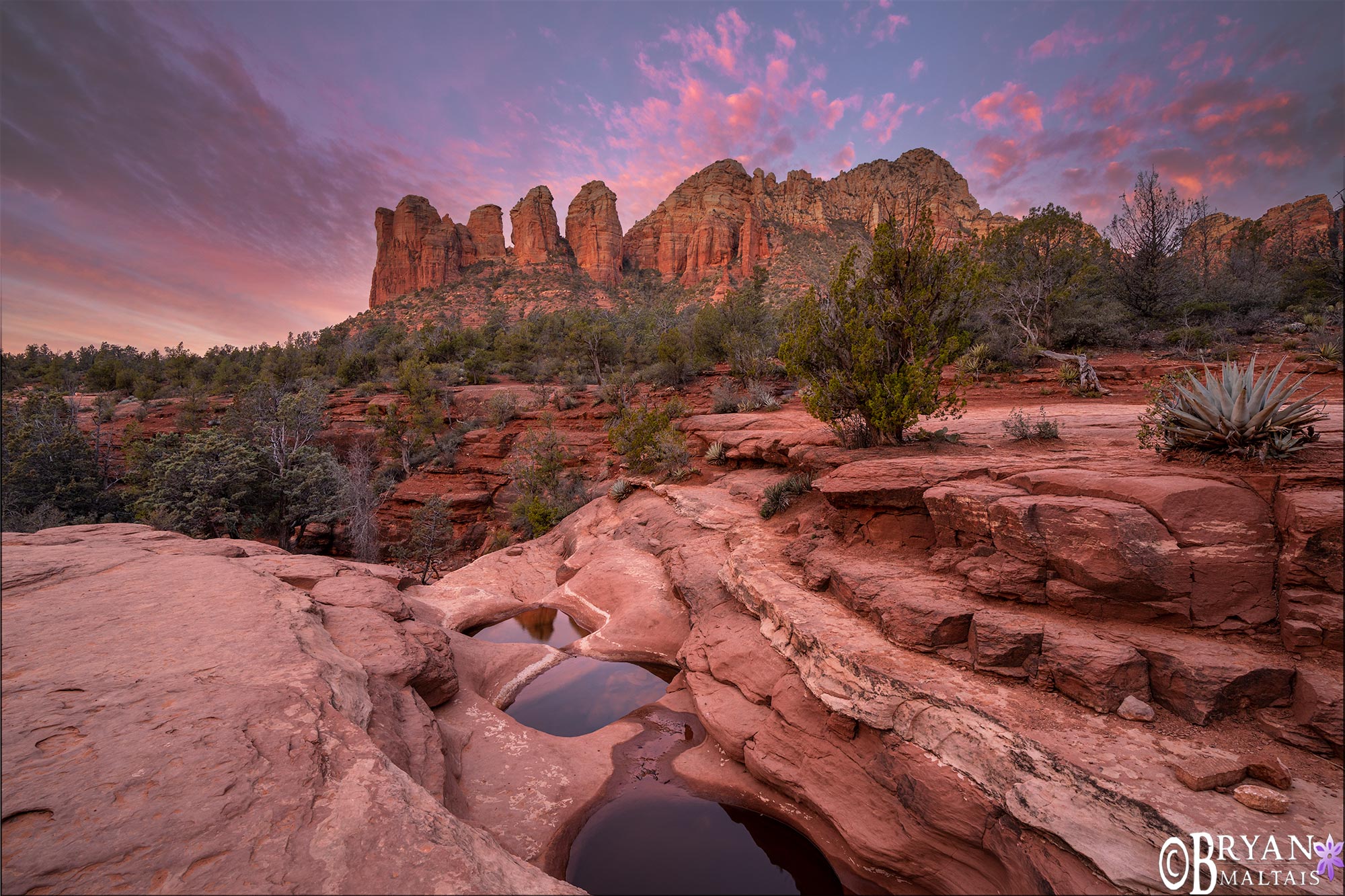 I’ve returned to this spot in Sedona for several years before finally capturing it with clouds at sunrise.
I’ve returned to this spot in Sedona for several years before finally capturing it with clouds at sunrise.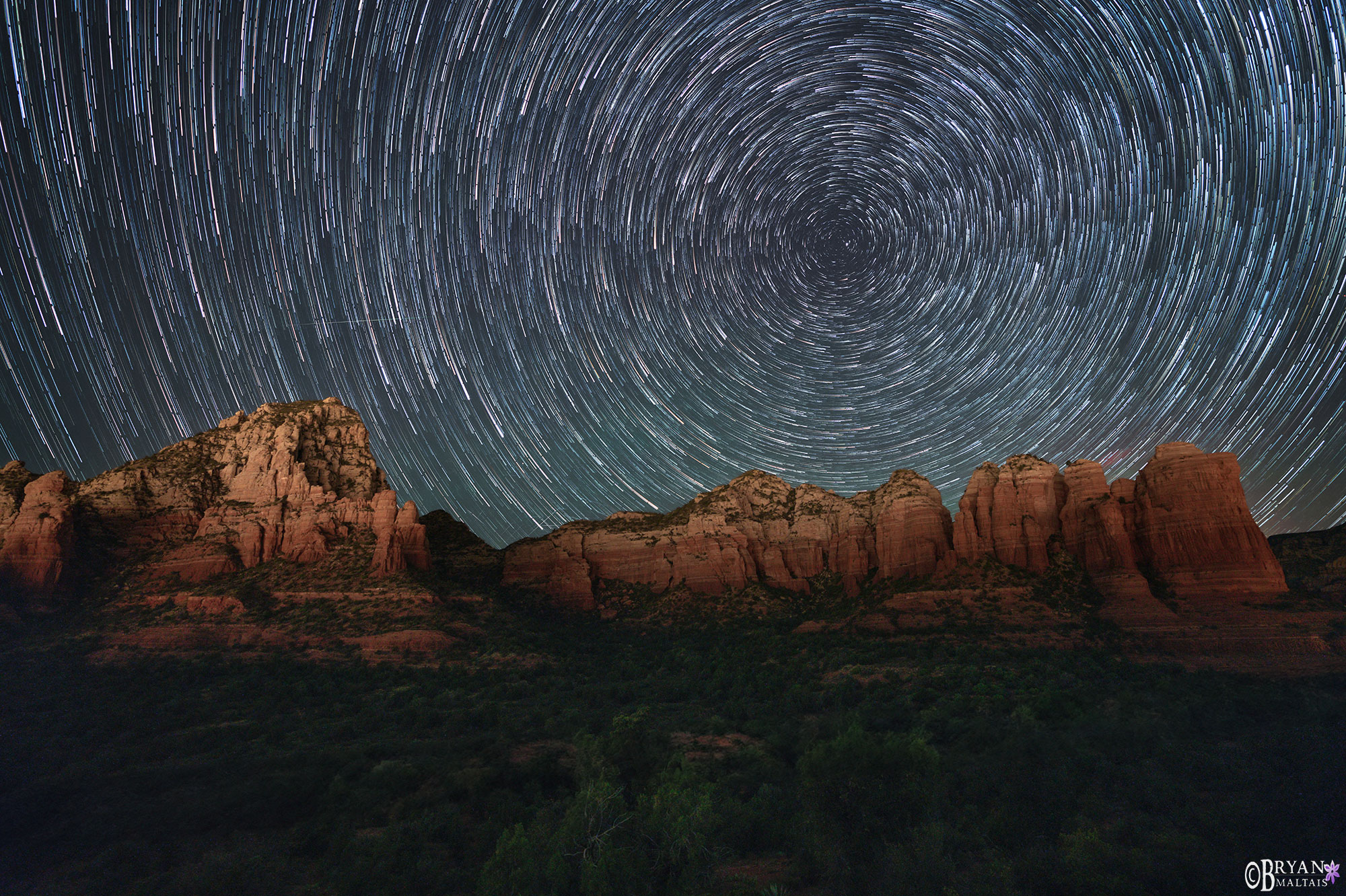 Star trails above the Schnebly Hill Formation in Sedona, AZ. As the earth rotates while photographing a fixed area of the sky for a long duration, the light of the spinning stars naturally leaves behind trails in the photo. You can capture concentric rings when framing Polaris near the center of the photo. To make the image above, I photographed the stars in the northern sky continuously for 2 hours, giving me 348 exposures.
Star trails above the Schnebly Hill Formation in Sedona, AZ. As the earth rotates while photographing a fixed area of the sky for a long duration, the light of the spinning stars naturally leaves behind trails in the photo. You can capture concentric rings when framing Polaris near the center of the photo. To make the image above, I photographed the stars in the northern sky continuously for 2 hours, giving me 348 exposures.
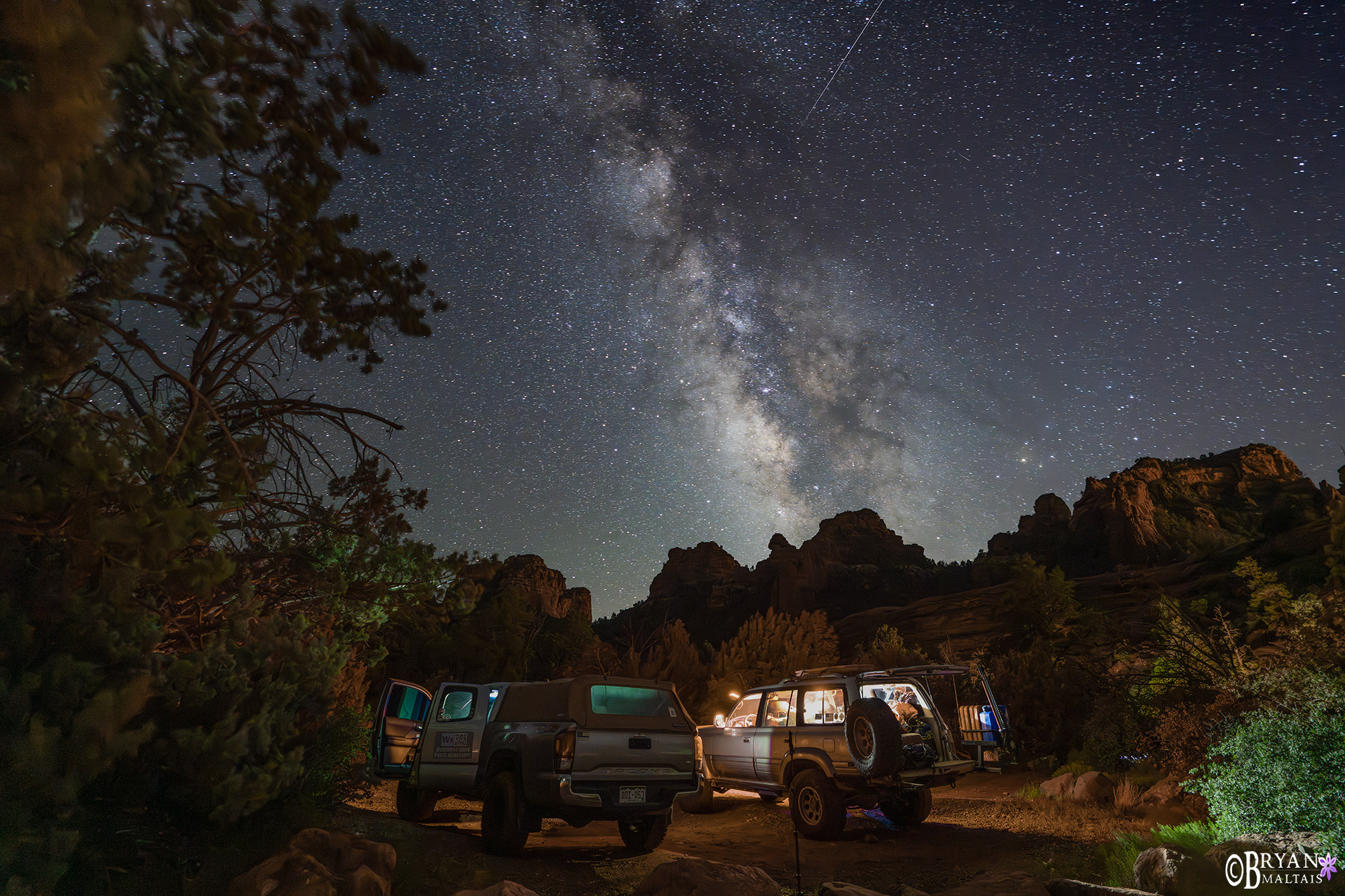 I photographed the Milky Way above our trucks while on a photo excursion with a friend on the outskirts of Sedona. You can see a streak from the Perseid meteor shower.
I photographed the Milky Way above our trucks while on a photo excursion with a friend on the outskirts of Sedona. You can see a streak from the Perseid meteor shower.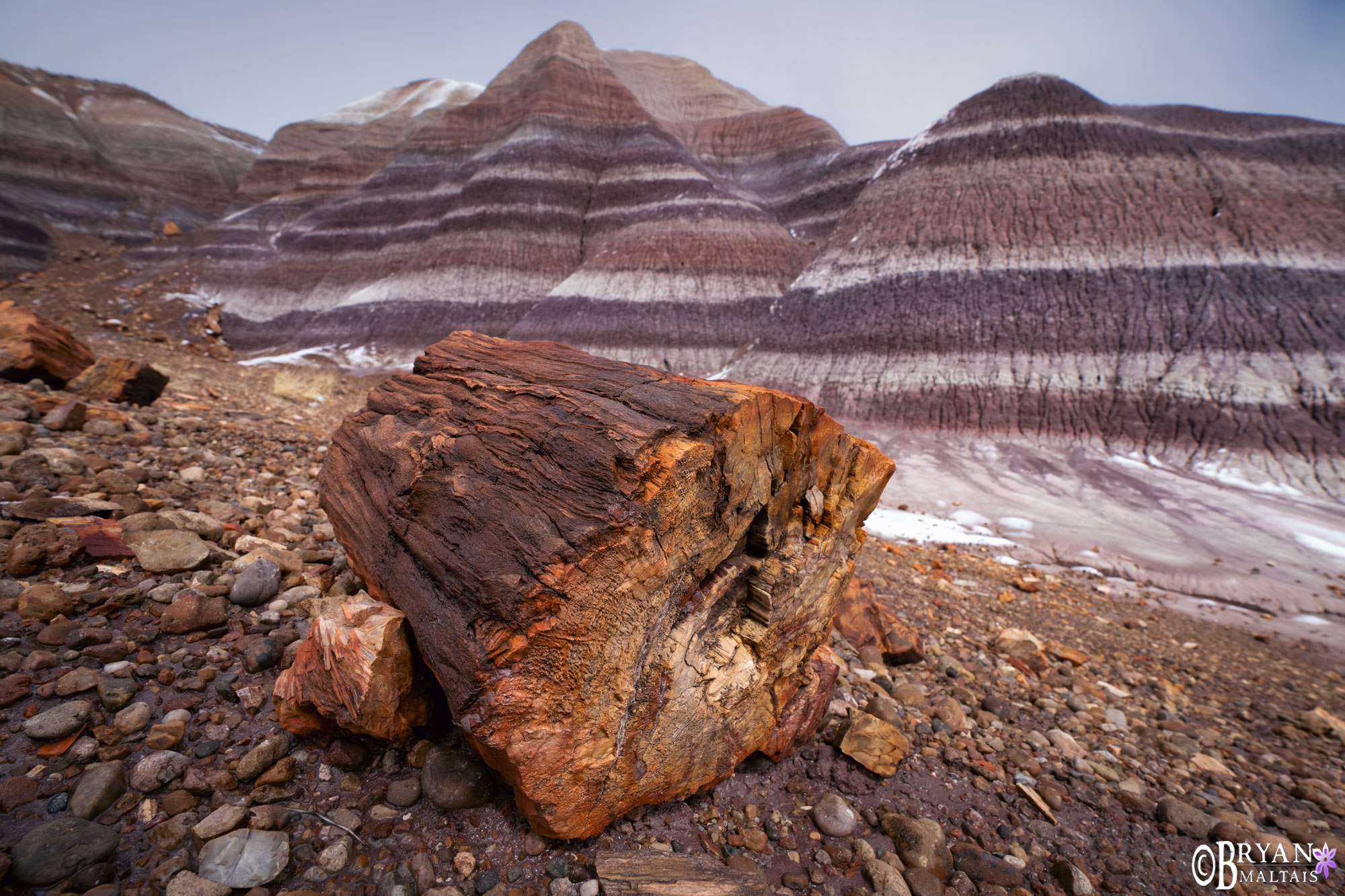 Petrified Forest National Monument, AZ contains contains bizarre sedimentary strat and petrified wood, exposed by a cataclysmic flood. I happened to be here during a rare snow storm, which you can see the remnants of sticking to the mud.
Petrified Forest National Monument, AZ contains contains bizarre sedimentary strat and petrified wood, exposed by a cataclysmic flood. I happened to be here during a rare snow storm, which you can see the remnants of sticking to the mud.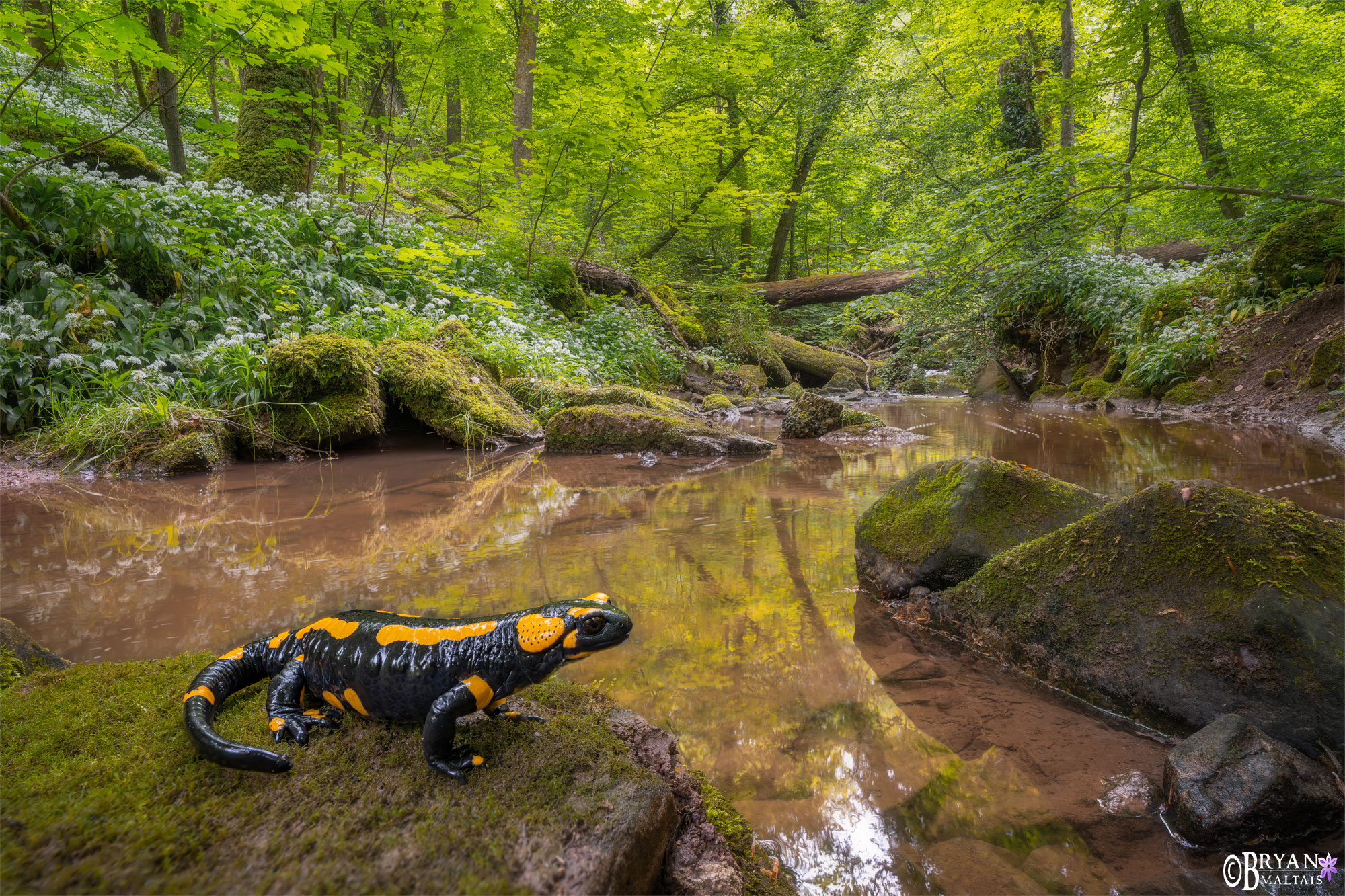 I photographed this Fire Salamander in a small forest near Stuttgart in Baden-Württemberg, Germany in May 2023. It’s a good photo to break down the technique used because it was technically challenging to create. It’s also personally meaningful because each element within the photo is among my most treasured things; home, forest, water and animal.
I photographed this Fire Salamander in a small forest near Stuttgart in Baden-Württemberg, Germany in May 2023. It’s a good photo to break down the technique used because it was technically challenging to create. It’s also personally meaningful because each element within the photo is among my most treasured things; home, forest, water and animal.
I previsualized this image before I took it by imagining the most beautiful scene possible based on the natural features available to me in the region. I’ve visited this forest many times before and knew it had everything that I needed to create this picture. I wanted the final image to contain elements that conveyed Fire Salamander ecology and the serenity of a European forest in spring. The white flowers with green foliage covering the hillsides are Bärlauch (Wild Garlic). They’re indicative of ideal Fire Salamander habitat and bloom during the Salamanders’ peak spawning period. The stream is a powerful feature that evokes tranquility and is where Fire Salamanders spawn. Unlike most Salamanders that lay eggs, Fire Salamanders bear developed larvae that have already hatched within the mother. While most German forests are logged and pruned of dead wood, this one is left to grow naturally with fallen trees left where they lay. This let me include trunks criss-crossing the forest to impart an old-growth vibe. Bringing this vision to fruition was just a matter of scouting the brook until I found a spot where these elements congealed, and then finding a Salamander to place in the scene.
I wanted everything from front to back to be in focus because each element is important for the narrative. I used focus stacking to achieve this because a single photo lacks the required depth of field to capture both a close foreground subject and the background in sharp focus. Focus stacking is when you take 1 photo for each slice of focus and then merge them into a single composite where every part of the photo has fine detail. It took 52 photos to cover everything from front to back. I merged the final image using Zerene Stacker. 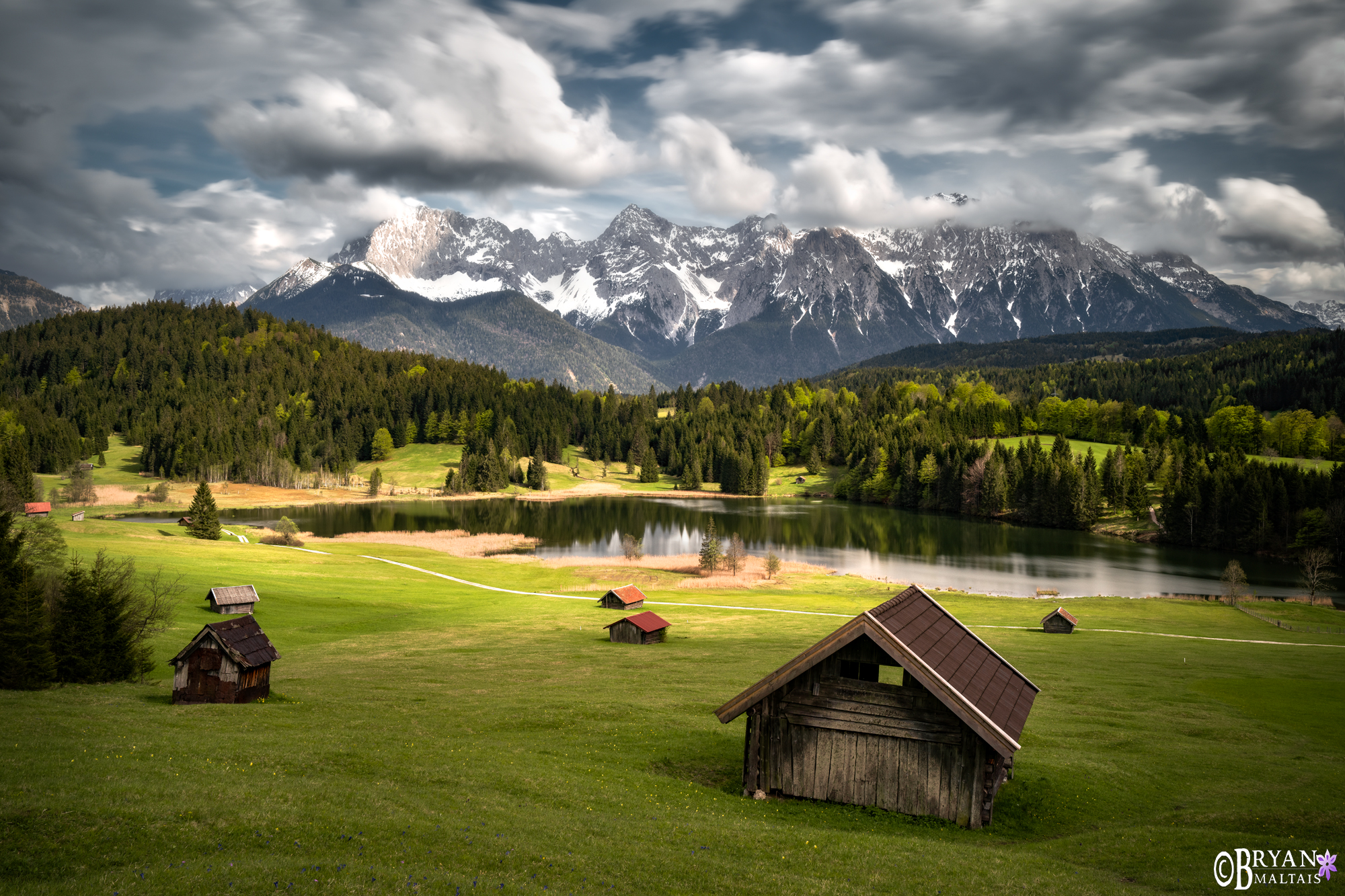 This pasture in the Bavarian Alps had an ambience that you could cut with a knife. The fresh air was brisk and permeated with the smell wildflowers and wood burning stoves. The Karwendel mountain range in the background forms part of the border between Germany and Austria.
This pasture in the Bavarian Alps had an ambience that you could cut with a knife. The fresh air was brisk and permeated with the smell wildflowers and wood burning stoves. The Karwendel mountain range in the background forms part of the border between Germany and Austria.
This is a 25 second exposure using a 10-stop neutral density filter to capture the natural dramatic movement of the clouds. This photo represents a fleeting moment. Minutes before, there weren’t enough clouds, and moments later clouds completely covered the mountains for 4 days. This was taken in mid May when the mountains still have snow and the landscape is lush green.
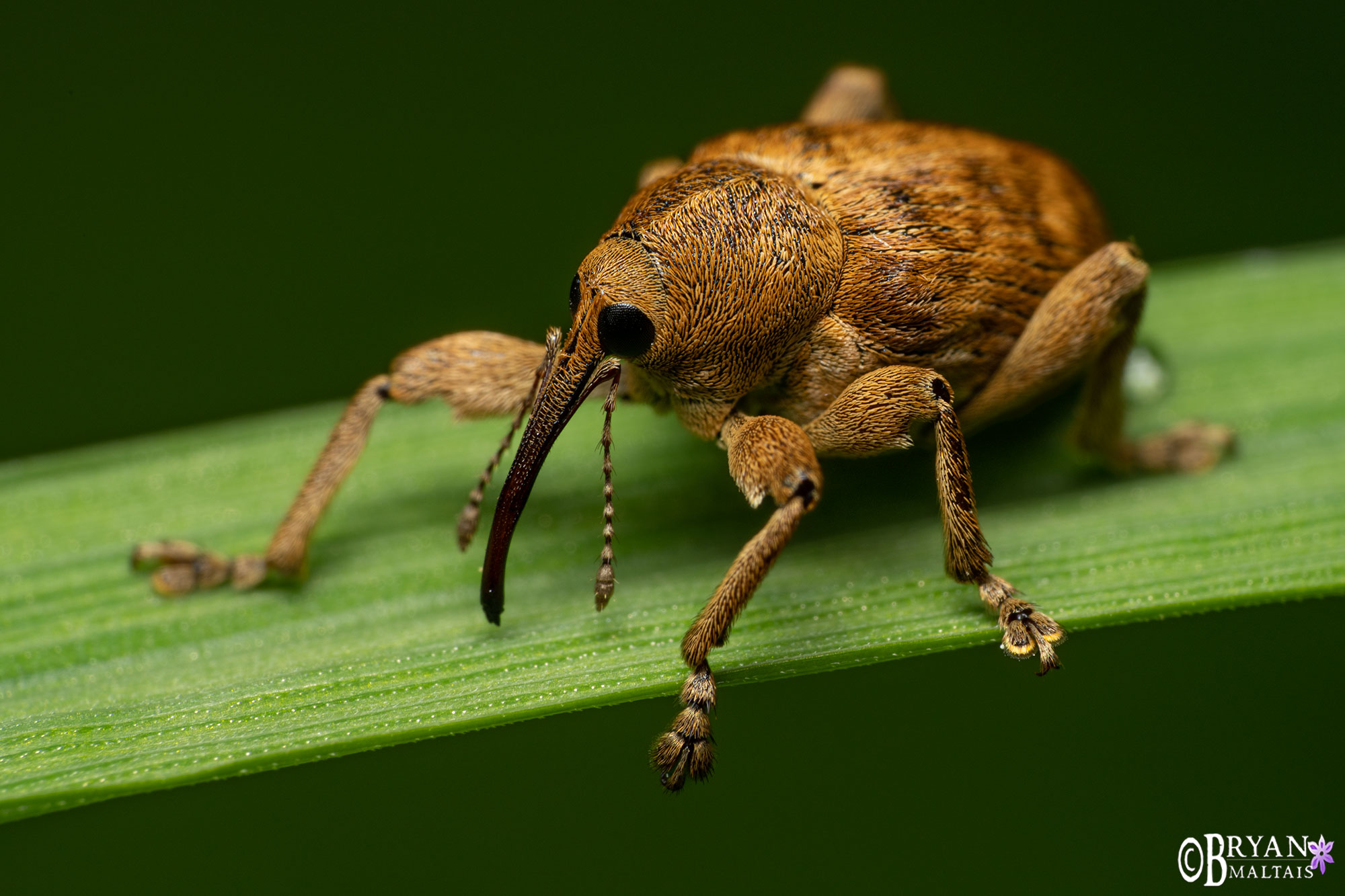 Along with visiting family, getting to do macro photography in the Beech forest was another highlight of my trip to Germany. This Nut Weevil is less than .5″ yet occupies the whole frame at 3x magnification. Sony A7rV , Venus Laowa 90mm 2x macro lens, Raynox 250 close-up adapter, Godox TT350 Flash, Angler Flash Diffuser. f/16, 1/250th, ISO 100
Along with visiting family, getting to do macro photography in the Beech forest was another highlight of my trip to Germany. This Nut Weevil is less than .5″ yet occupies the whole frame at 3x magnification. Sony A7rV , Venus Laowa 90mm 2x macro lens, Raynox 250 close-up adapter, Godox TT350 Flash, Angler Flash Diffuser. f/16, 1/250th, ISO 100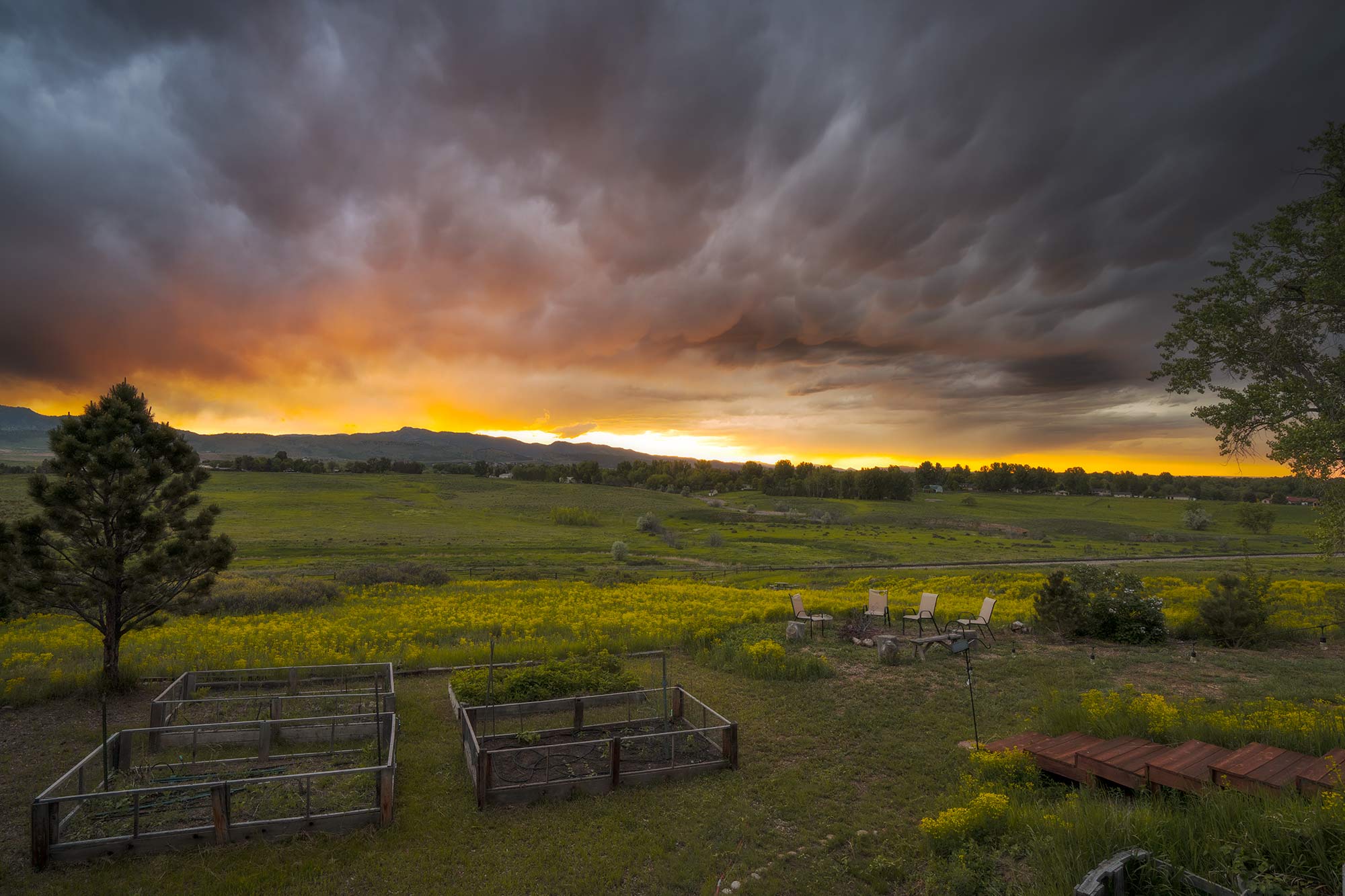 There are few places I’d rather be in May than my own backyard. The normally dry front-range turns vivid green for a few weeks and is filled with natural drama. Watching the storms roll in during the rainy season is mesmerizing. The first half of 2023 dropped an amazing 24″ of rain on the area; we normally receive only 15″ annually. Incidentally, the sprawling yellow flowers are Leafy Spurge, an invasive weed that’s being mitigated in this space.
There are few places I’d rather be in May than my own backyard. The normally dry front-range turns vivid green for a few weeks and is filled with natural drama. Watching the storms roll in during the rainy season is mesmerizing. The first half of 2023 dropped an amazing 24″ of rain on the area; we normally receive only 15″ annually. Incidentally, the sprawling yellow flowers are Leafy Spurge, an invasive weed that’s being mitigated in this space.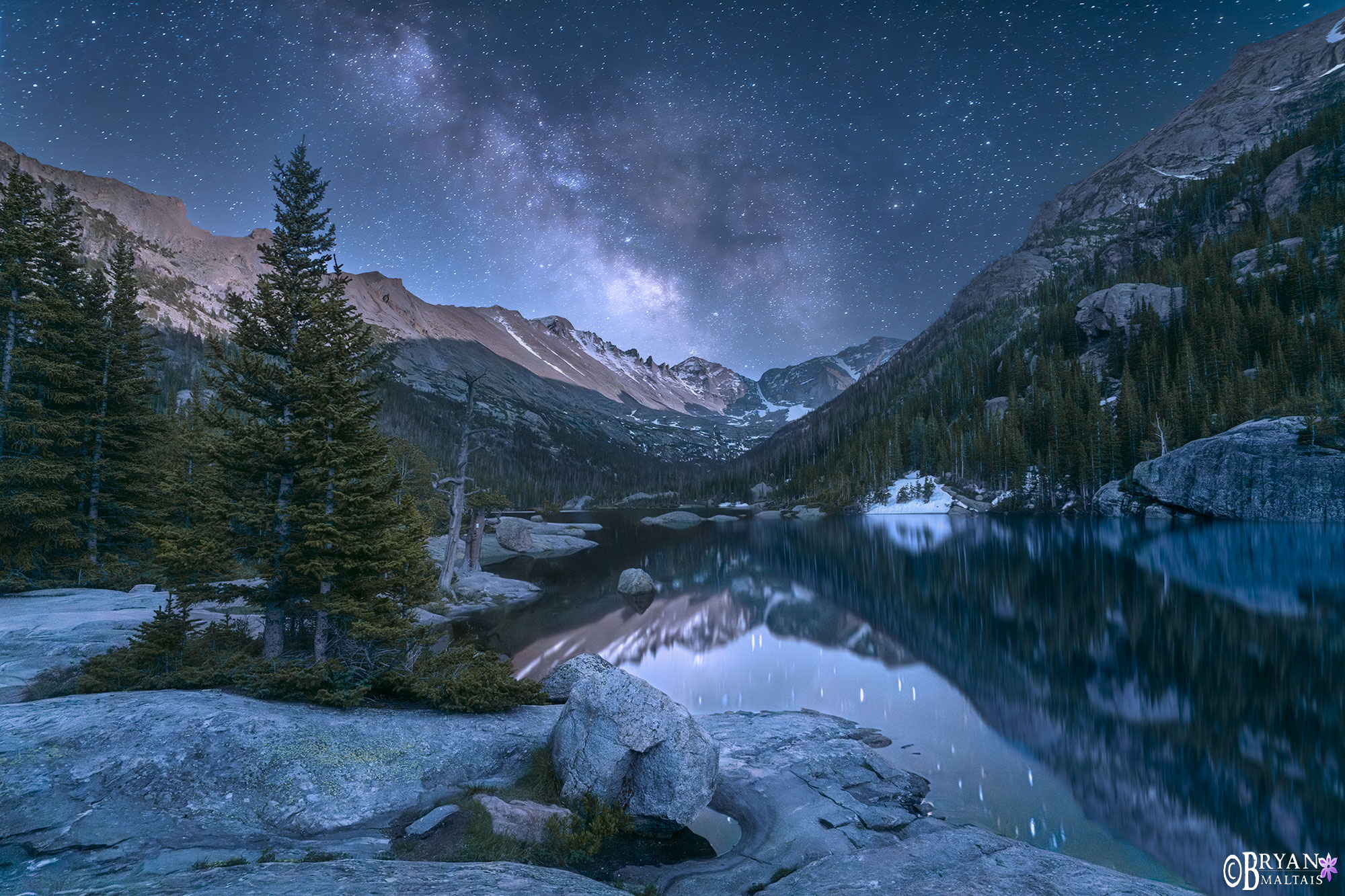 I took this photo during Milky Way week in June at Mills Lake, Rocky Mountain National Park. It’s a blend of one shot taken during blue hour, and another 3.5 hours later when the Milky Way was risen. The result of this technique is an evenly exposed scene where the foreground is visible and detailed. Without this technique the foreground would be a black silhouette with no detail. Though it’s possible to add exposure to the foreground artificially by moving the shadows slider in Adobe, this results in such extreme noise that the photo isn’t usable. An alternative to blue hour shooting would have been light painting. Though useful, the disadvantage is that the mountains would have been dark.
I took this photo during Milky Way week in June at Mills Lake, Rocky Mountain National Park. It’s a blend of one shot taken during blue hour, and another 3.5 hours later when the Milky Way was risen. The result of this technique is an evenly exposed scene where the foreground is visible and detailed. Without this technique the foreground would be a black silhouette with no detail. Though it’s possible to add exposure to the foreground artificially by moving the shadows slider in Adobe, this results in such extreme noise that the photo isn’t usable. An alternative to blue hour shooting would have been light painting. Though useful, the disadvantage is that the mountains would have been dark. 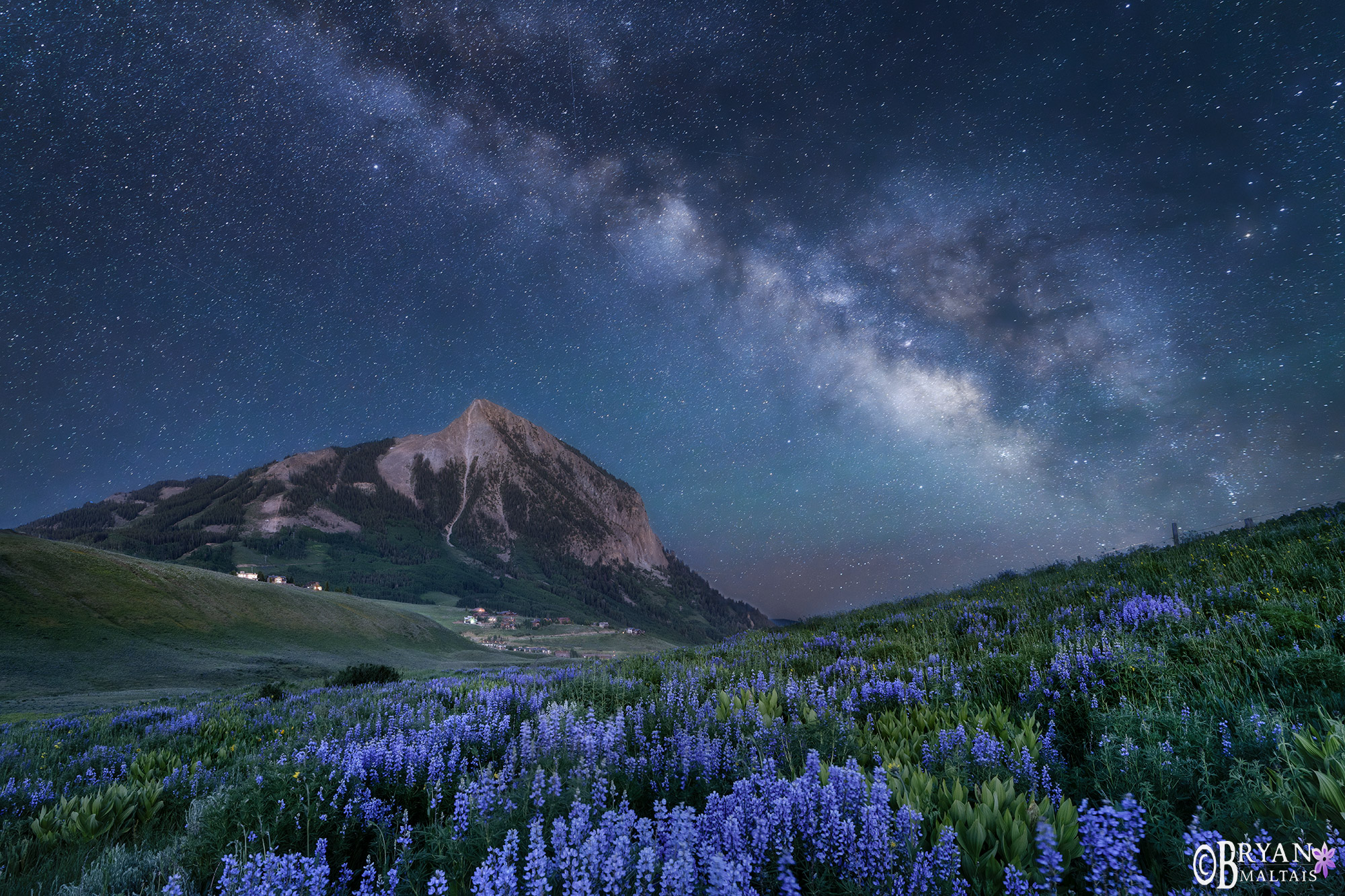 I made my annual wildflower trip to Crested Butte in mid July. Having been such a wet/snowy year, the wildlfowers were amazing at low elevations, but the high-country was still plugged with snow. This photo is a blur hour/Milky Way blend blend.
I made my annual wildflower trip to Crested Butte in mid July. Having been such a wet/snowy year, the wildlfowers were amazing at low elevations, but the high-country was still plugged with snow. This photo is a blur hour/Milky Way blend blend.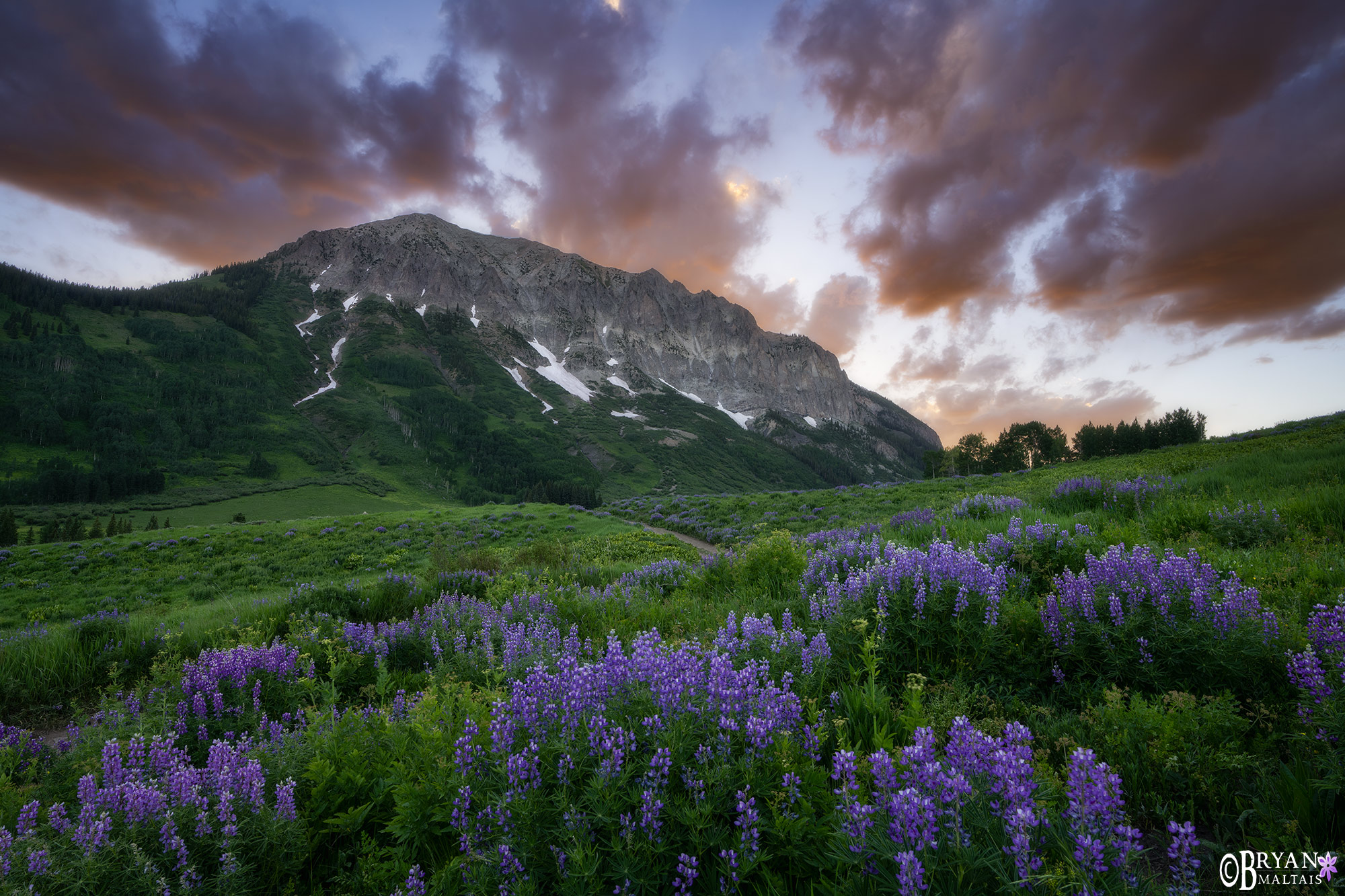 Some of the best shots are captured during the crimson colors of alpenglow after the sun has set. It created beautiful conditions where the purple Lupines were complimented by the orange sky and green meadow.
Some of the best shots are captured during the crimson colors of alpenglow after the sun has set. It created beautiful conditions where the purple Lupines were complimented by the orange sky and green meadow.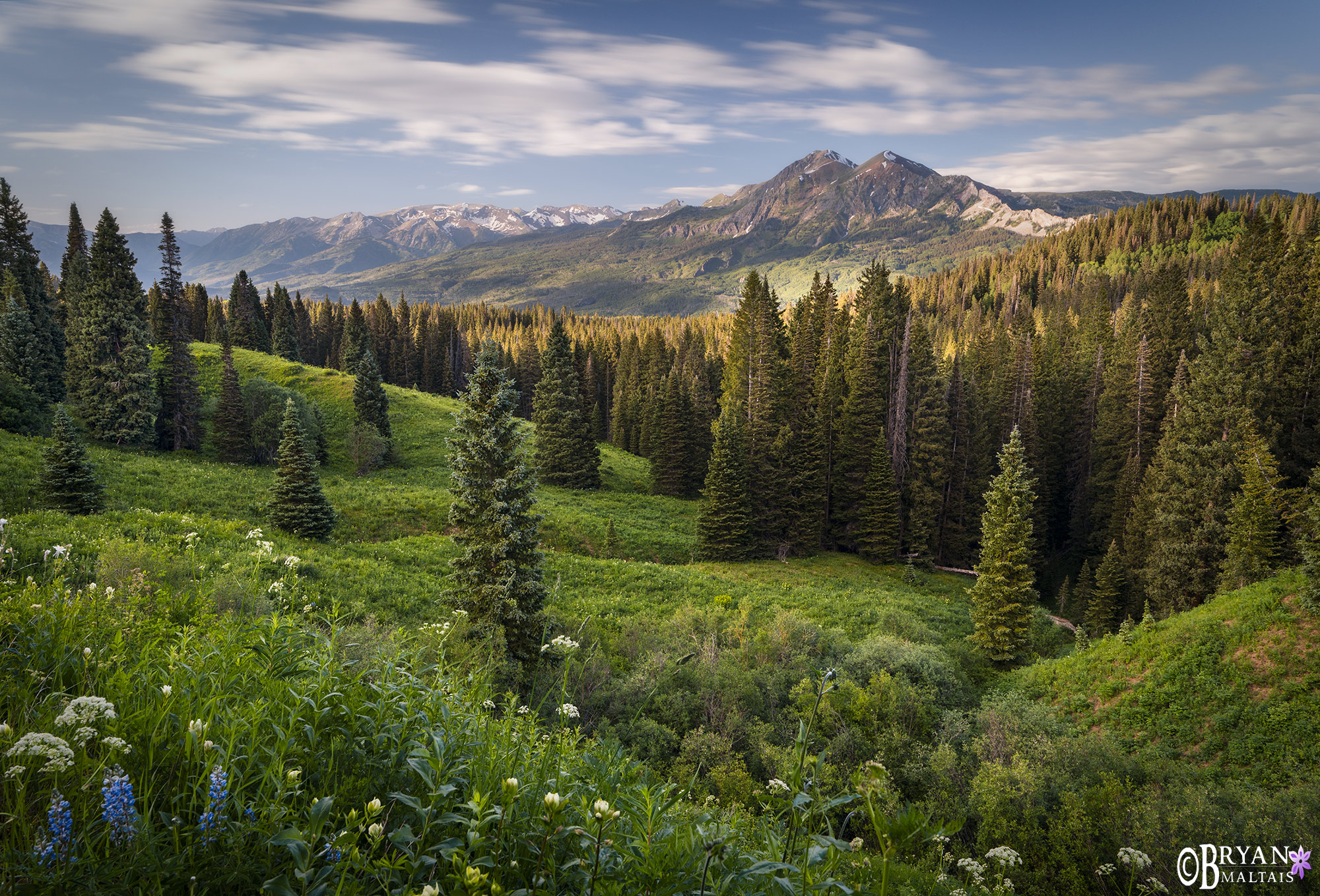 Hiking a little higher up above Crested Butte’s Kebler Pass Road yields sweeping views of the West Elk Mountains.
Hiking a little higher up above Crested Butte’s Kebler Pass Road yields sweeping views of the West Elk Mountains.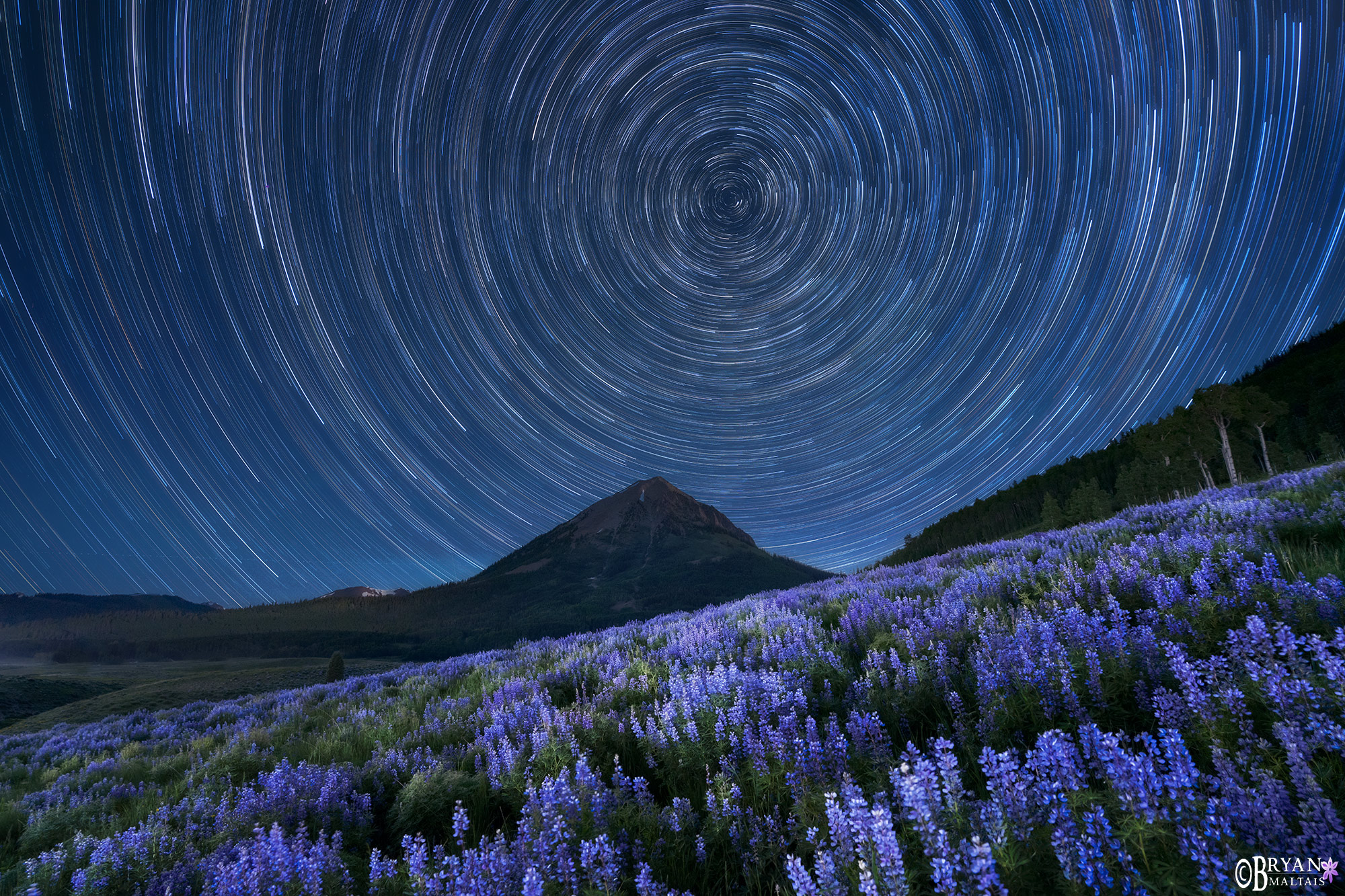 This photo of circumpolar star trails above Gothic Mountain was made with 240 minutes of continuous exposures. The meadow was illuminated when the extremely bright headlights of a distant 4×4 briefly shined on the field.
This photo of circumpolar star trails above Gothic Mountain was made with 240 minutes of continuous exposures. The meadow was illuminated when the extremely bright headlights of a distant 4×4 briefly shined on the field. 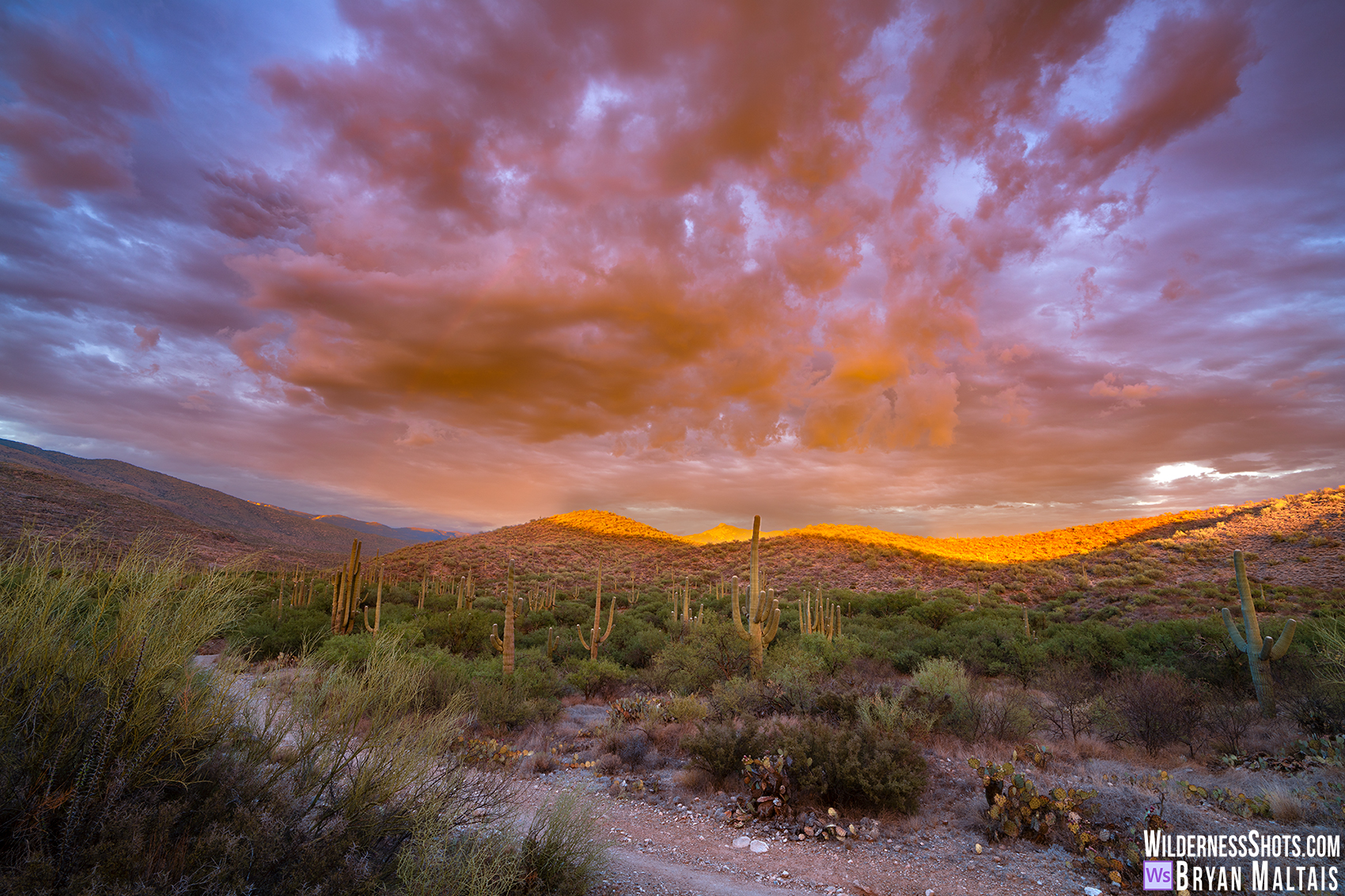 Something strange happens during sunset in the Sonora Desert; red afterglow occurs while the sun is still up. In most regions, this doesn’t happen until well after sunset. Afterglow normally occurs because the already set sun is still sending light rays through the Earths atmosphere from a very low angle below the horizon. At this angle, the light must pass through a longer distance of atmosphere than when the sun is directly overhead. As it travels through the atmosphere, the blue wavelengths are filtered out, leaving only warm hues. In southern Arizona, the apparent reason for early afterglow is because fine dust from the dry desert hangs in the upper atmosphere, which filters out the blue wavelengths.
Something strange happens during sunset in the Sonora Desert; red afterglow occurs while the sun is still up. In most regions, this doesn’t happen until well after sunset. Afterglow normally occurs because the already set sun is still sending light rays through the Earths atmosphere from a very low angle below the horizon. At this angle, the light must pass through a longer distance of atmosphere than when the sun is directly overhead. As it travels through the atmosphere, the blue wavelengths are filtered out, leaving only warm hues. In southern Arizona, the apparent reason for early afterglow is because fine dust from the dry desert hangs in the upper atmosphere, which filters out the blue wavelengths.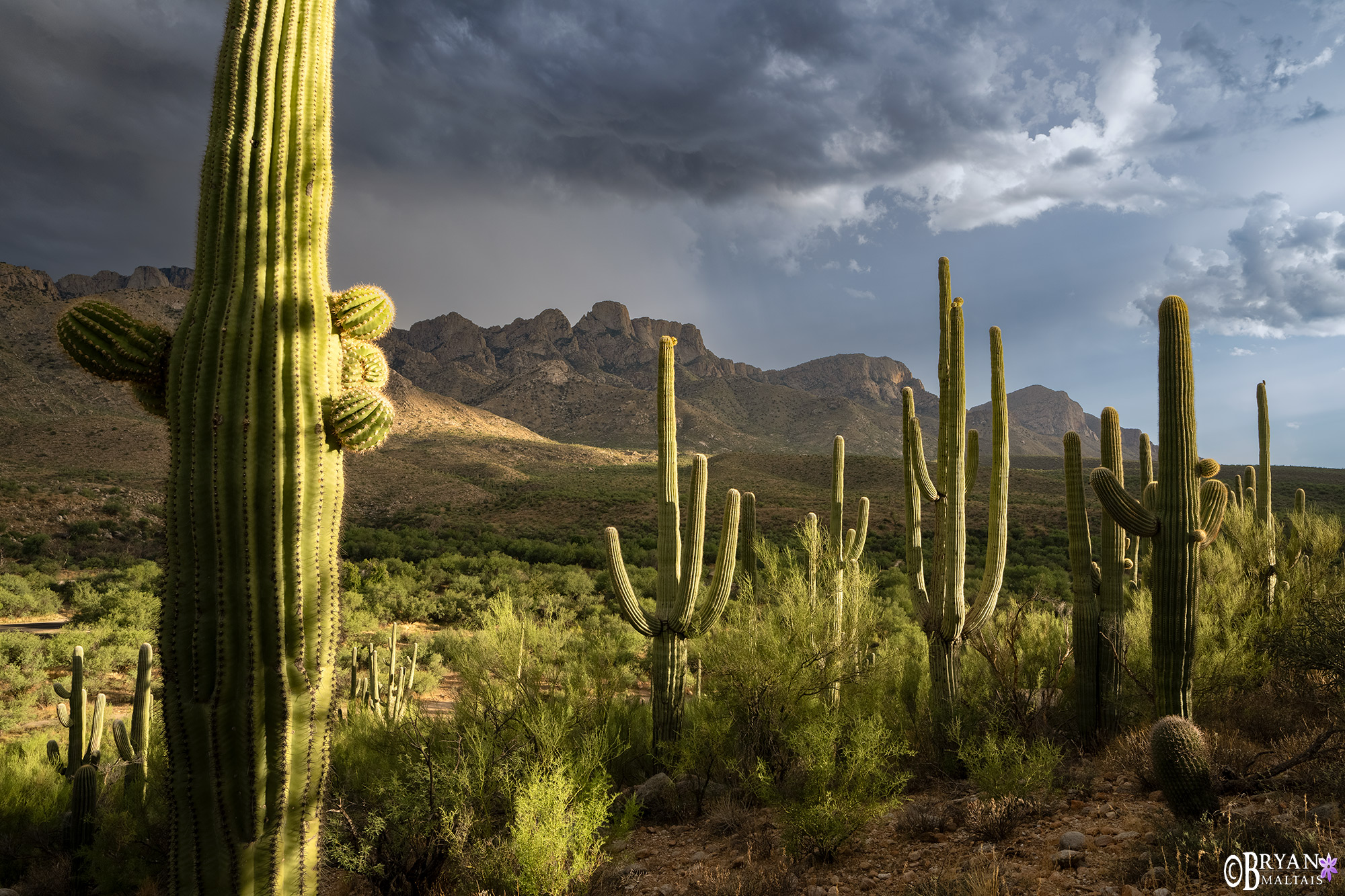 In August, the atmosphere in the Sonora desert is radiant with the churning of nature. Catalina State Park on the NW edge of Tucson is an exemplary slice of Saguaro desert scrub, framed by the Santa Catalina Mountains. When I visited, monsoon storms were brewing in two directions during golden hour.
In August, the atmosphere in the Sonora desert is radiant with the churning of nature. Catalina State Park on the NW edge of Tucson is an exemplary slice of Saguaro desert scrub, framed by the Santa Catalina Mountains. When I visited, monsoon storms were brewing in two directions during golden hour.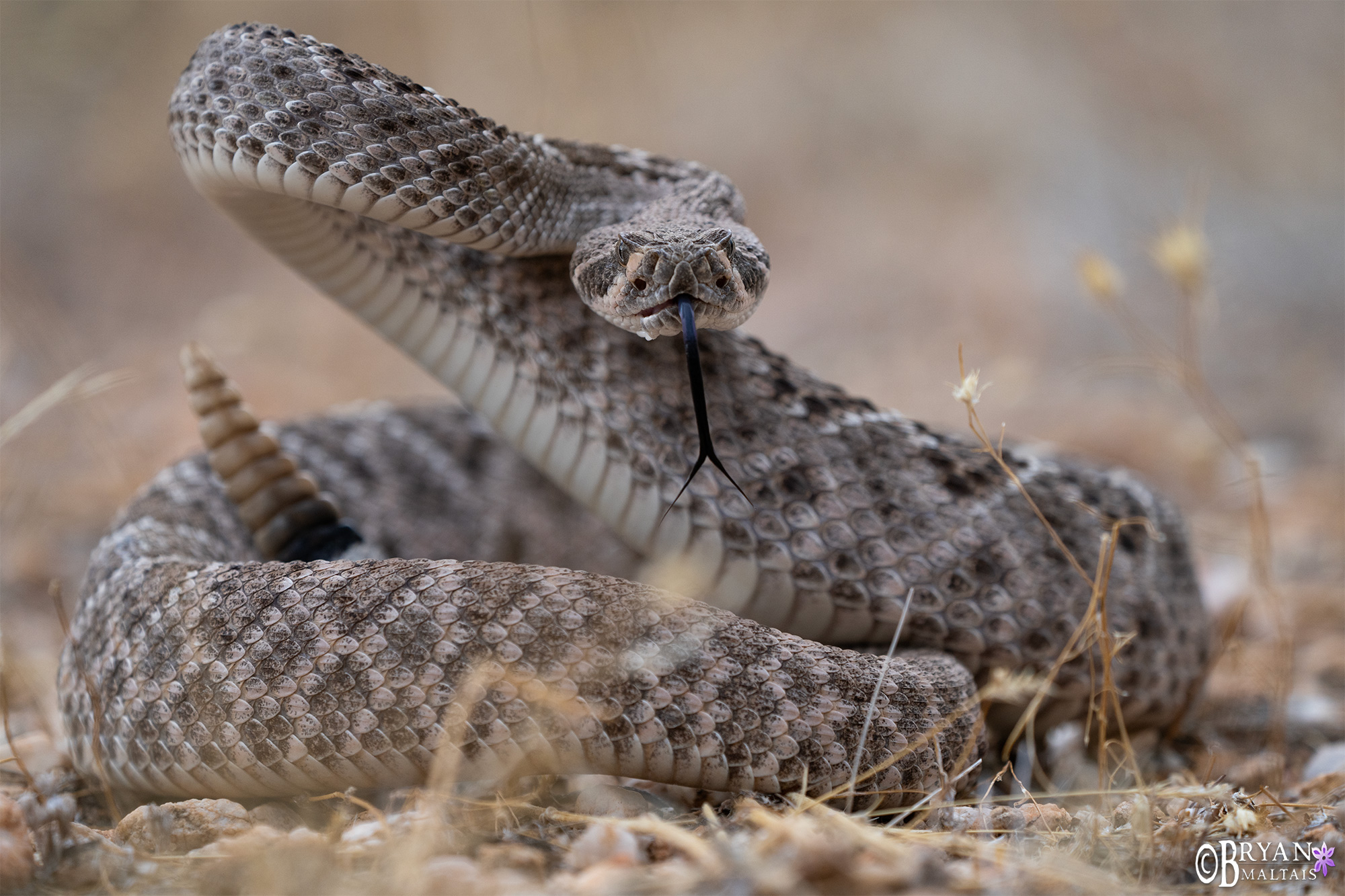 In my worldview, rattlesnakes like this Western Diamondback are virtually harmless. Most people don’t understand how I deliberately search for them without repeatedly being killed. This perception probably stems from the assumption that a long slender creature with a weapon of mass destruction on its head will bolt after you like a spear. In reality, rattlers are among the slowest moving snakes and don’t chase. They instinctively know they’re tasty treats for owls, roadrunners and coyotes, so they tend to slither in the opposite direction of danger. When coiled, rattling and primed to strike, rattlers are probably in their least dangerous posture for humans because they’re just a pile of snake that’s easily seen and avoided. Even then they usually don’t strike unless seriously cornered or harassed.
In my worldview, rattlesnakes like this Western Diamondback are virtually harmless. Most people don’t understand how I deliberately search for them without repeatedly being killed. This perception probably stems from the assumption that a long slender creature with a weapon of mass destruction on its head will bolt after you like a spear. In reality, rattlers are among the slowest moving snakes and don’t chase. They instinctively know they’re tasty treats for owls, roadrunners and coyotes, so they tend to slither in the opposite direction of danger. When coiled, rattling and primed to strike, rattlers are probably in their least dangerous posture for humans because they’re just a pile of snake that’s easily seen and avoided. Even then they usually don’t strike unless seriously cornered or harassed.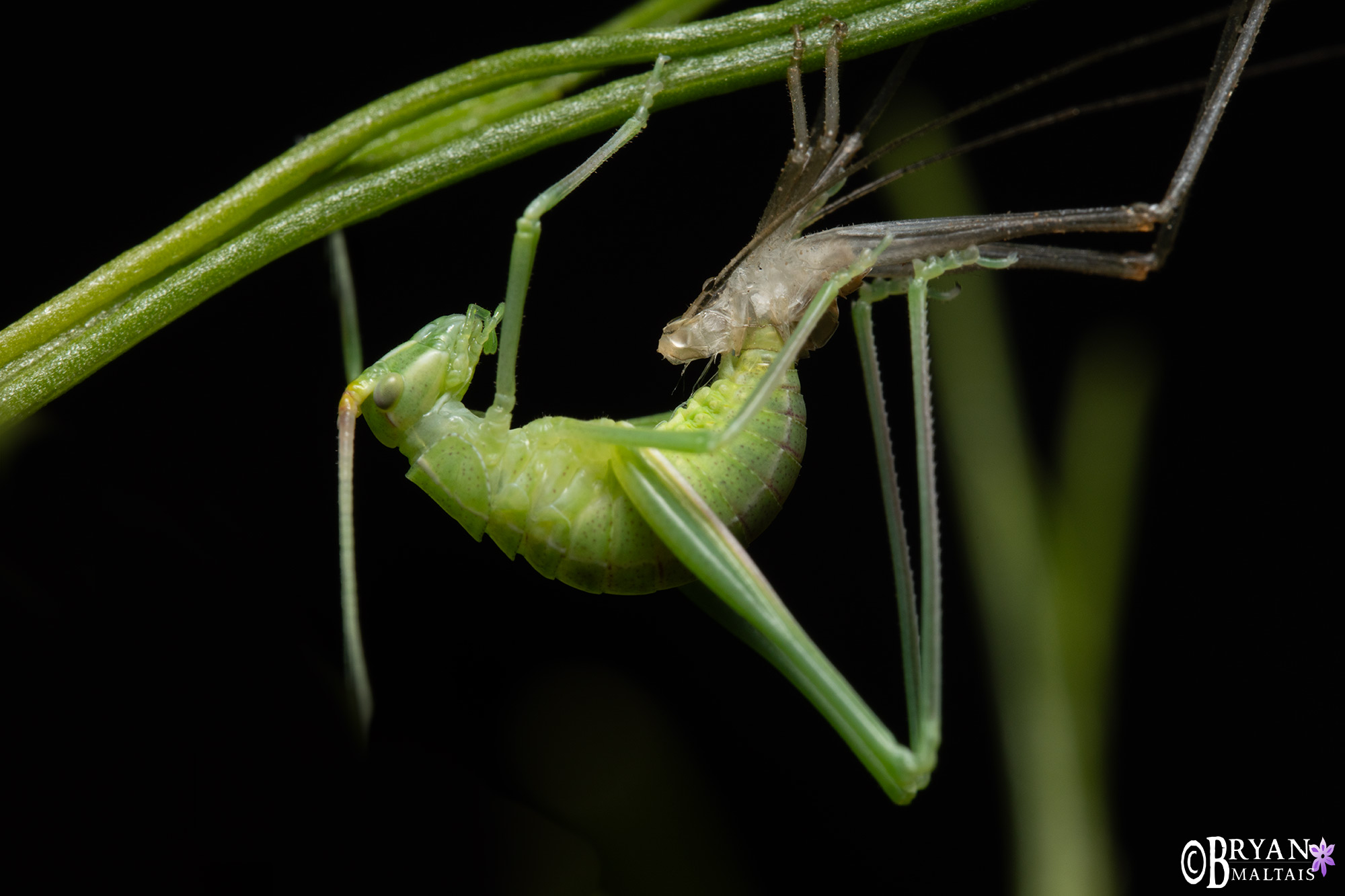 A molting Tree Cricket in the desert near Tucson.
A molting Tree Cricket in the desert near Tucson.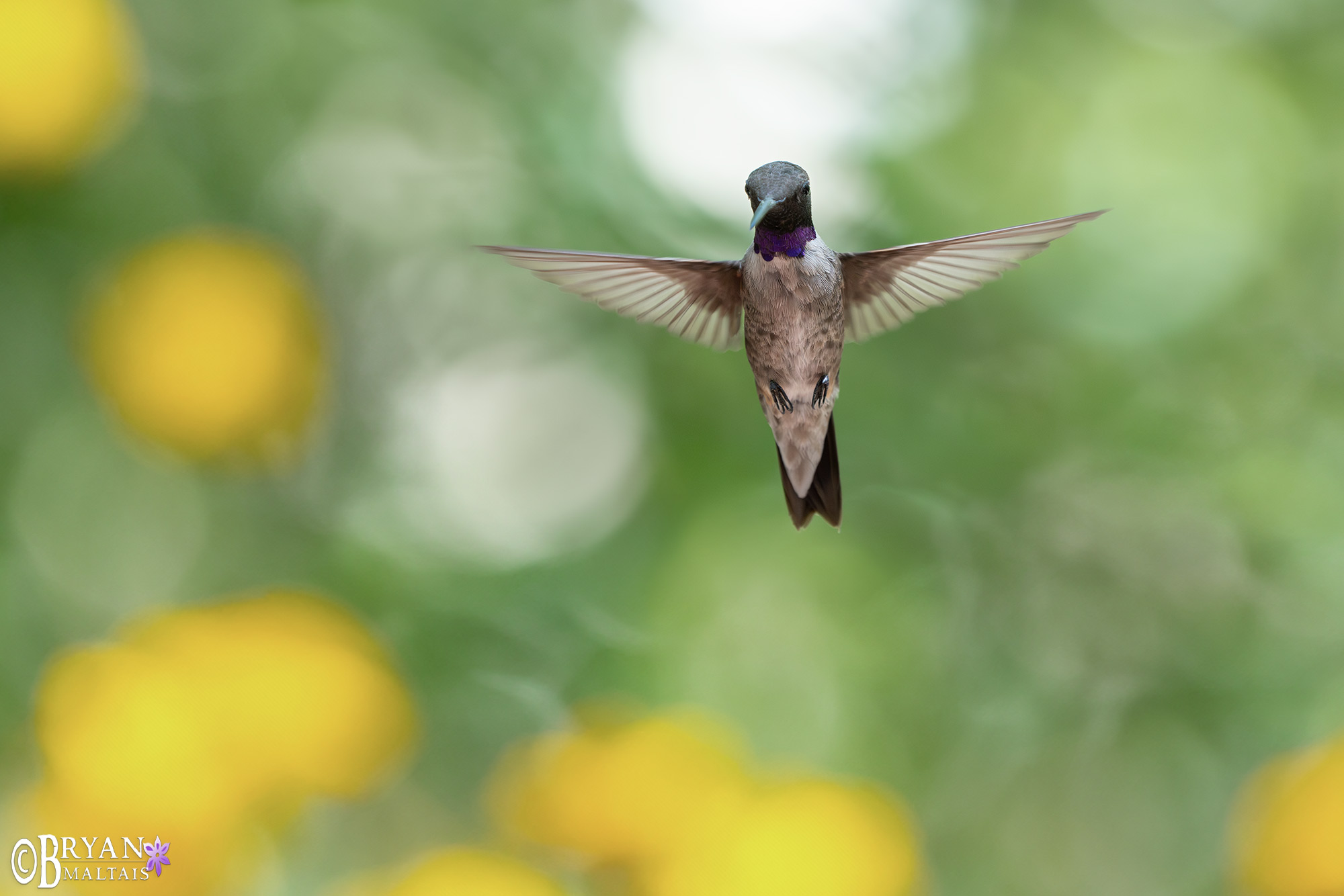 Southeast Arizona has the most hummingbird species in the US. While in the Sonora Desert, I visited several hummingbirds sanctuaries in Sierra Vista and Madera Canyon. The technical challenge of capturing sharp birds in flight was very fun.
Southeast Arizona has the most hummingbird species in the US. While in the Sonora Desert, I visited several hummingbirds sanctuaries in Sierra Vista and Madera Canyon. The technical challenge of capturing sharp birds in flight was very fun.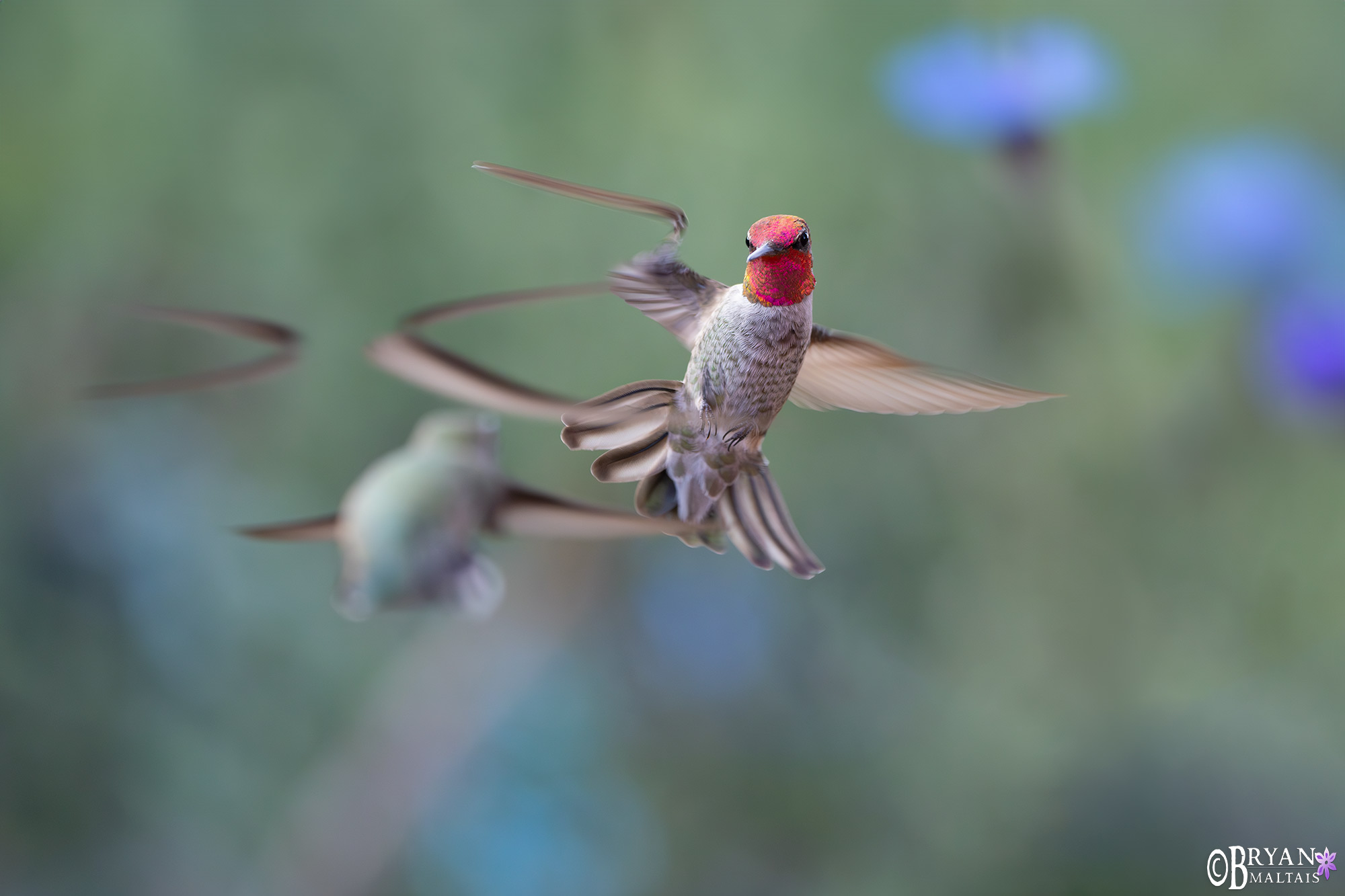
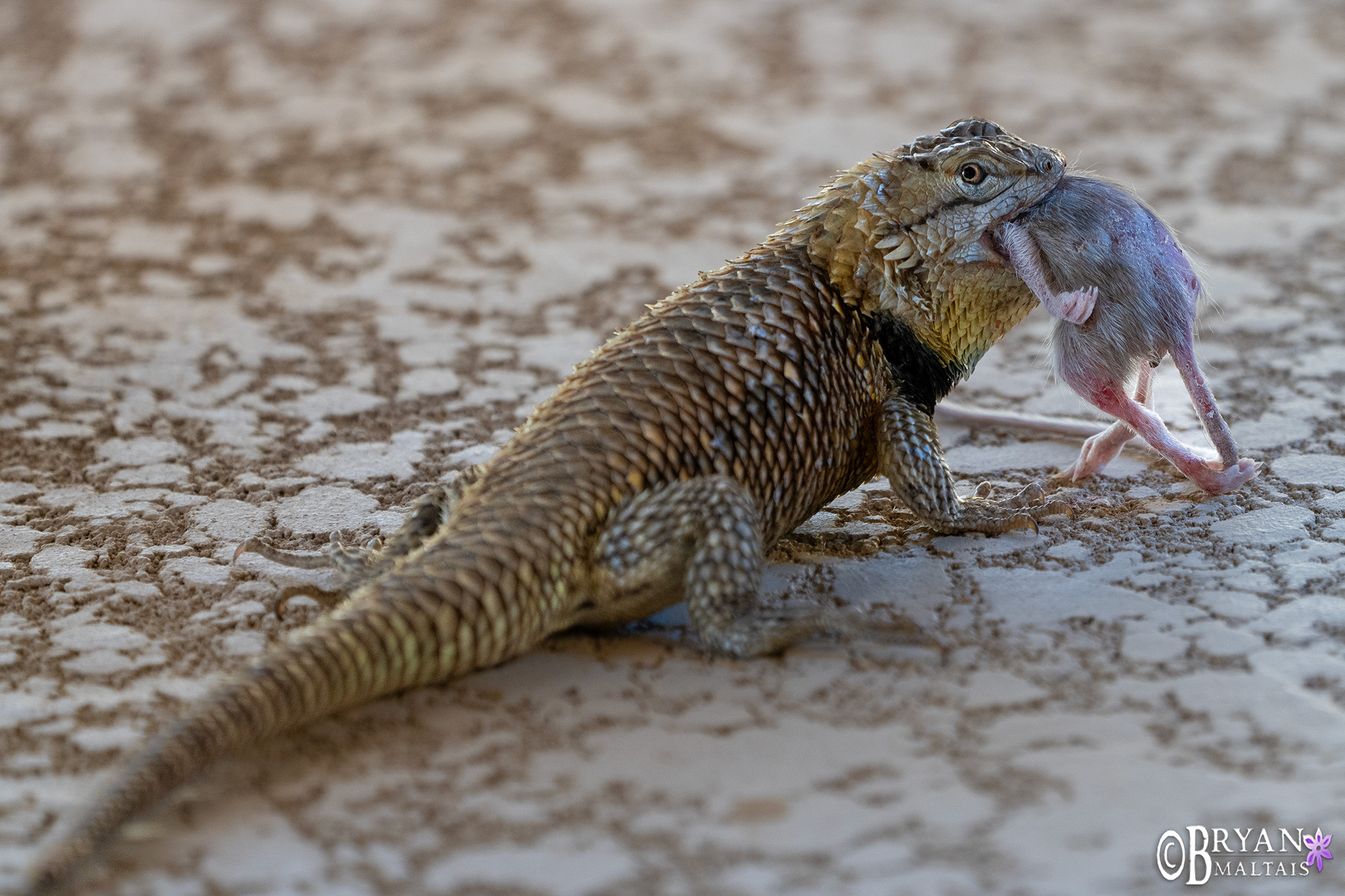 Though I hiked and drove many miles through the Sonora Desert to find interesting creatures, I encountered a particularly bizarre sight while sipping ice water on a friend’s patio in Phoenix. This bruiser of a male Desert Spiny Lizard walked by with a Pocket Mouse shoved in its mouth. I ran out to my truck to grab my Camera and 100-400mm lens. Amazingly, the lizard was still there when I returned. This picture is testament that most reptiles & amphibians simply consume any animal they can catch and swallow, regardless of taxa. Males of this rugged species also engage in brutal combat over territory, biting and flipping each other.
Though I hiked and drove many miles through the Sonora Desert to find interesting creatures, I encountered a particularly bizarre sight while sipping ice water on a friend’s patio in Phoenix. This bruiser of a male Desert Spiny Lizard walked by with a Pocket Mouse shoved in its mouth. I ran out to my truck to grab my Camera and 100-400mm lens. Amazingly, the lizard was still there when I returned. This picture is testament that most reptiles & amphibians simply consume any animal they can catch and swallow, regardless of taxa. Males of this rugged species also engage in brutal combat over territory, biting and flipping each other.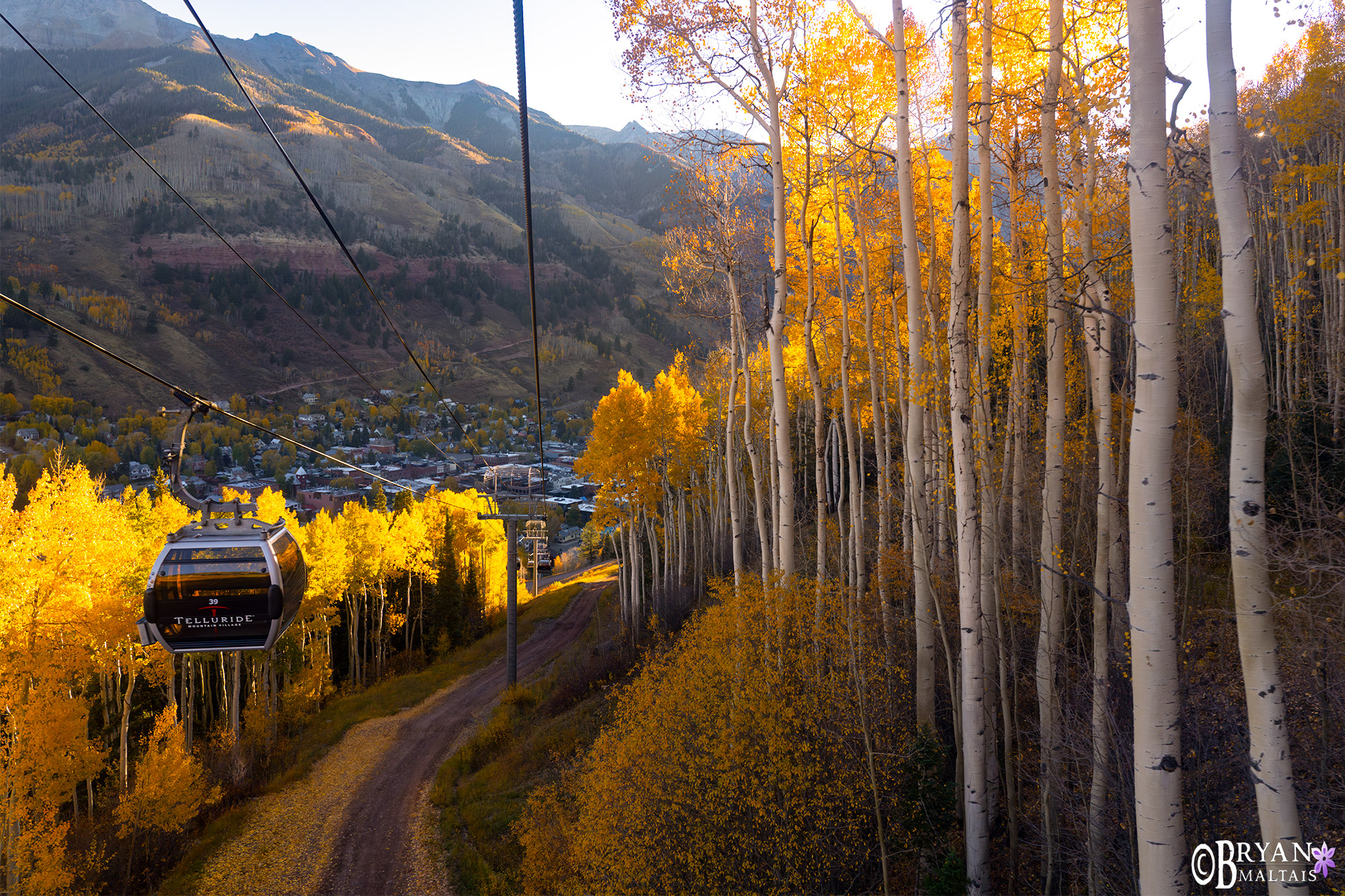 I shot this riding the free gondola coming from Mountain Village down into Telluride. I spent fall colors 2023 in the San Juan Mountains bouncing around Telluride, Ouray, Ridgway and Silverton. My time was a combination of leading photo workshops and shooting on my own. Fall colors lasted oddly long in the San Juan Mountains until about Oct. 15th.
I shot this riding the free gondola coming from Mountain Village down into Telluride. I spent fall colors 2023 in the San Juan Mountains bouncing around Telluride, Ouray, Ridgway and Silverton. My time was a combination of leading photo workshops and shooting on my own. Fall colors lasted oddly long in the San Juan Mountains until about Oct. 15th.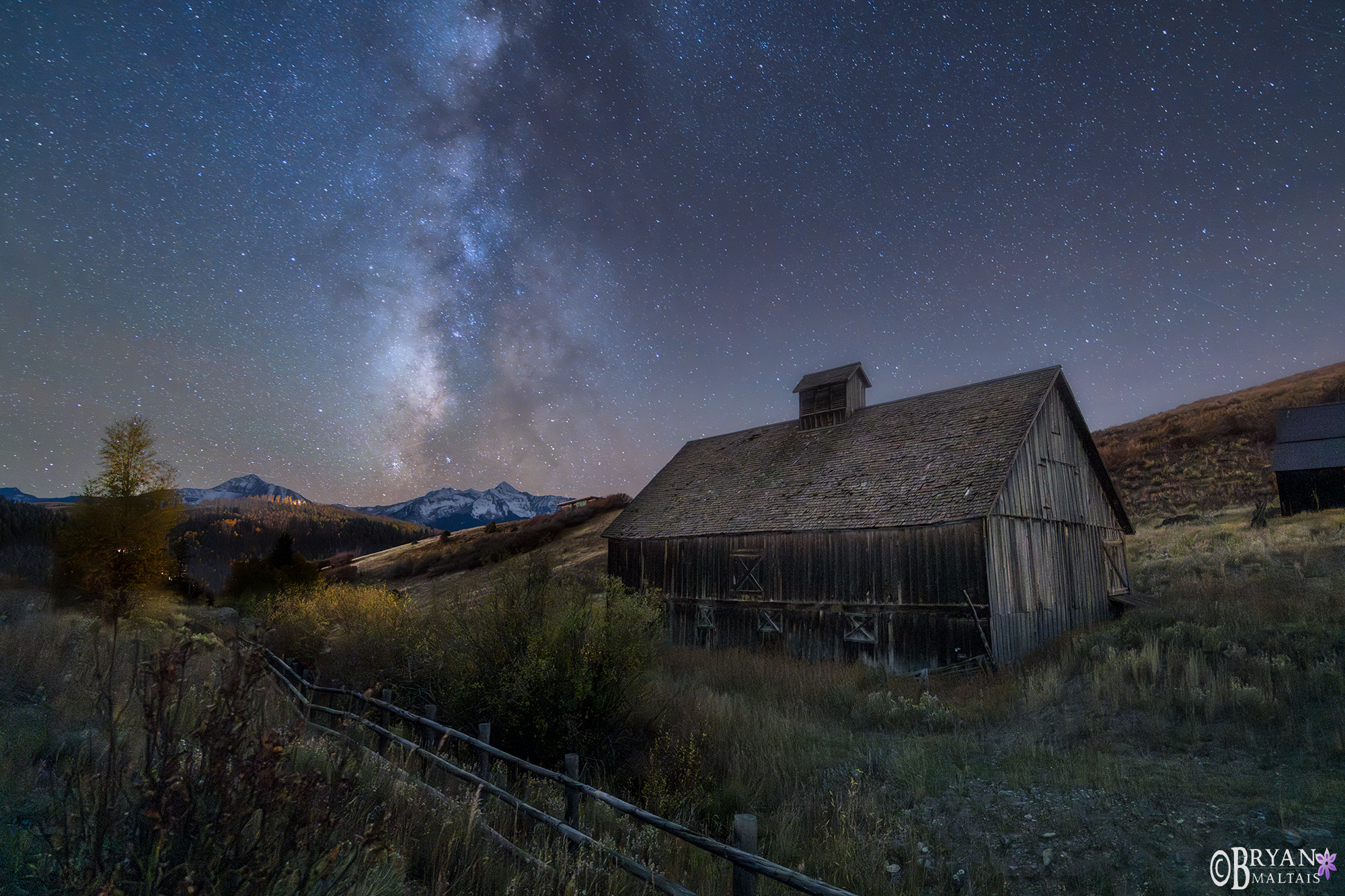 The nice thing about shooting the Milky Way in fall is that it’s risen when the night sky becomes dark so you don’t have to wait around long after sunset.
The nice thing about shooting the Milky Way in fall is that it’s risen when the night sky becomes dark so you don’t have to wait around long after sunset.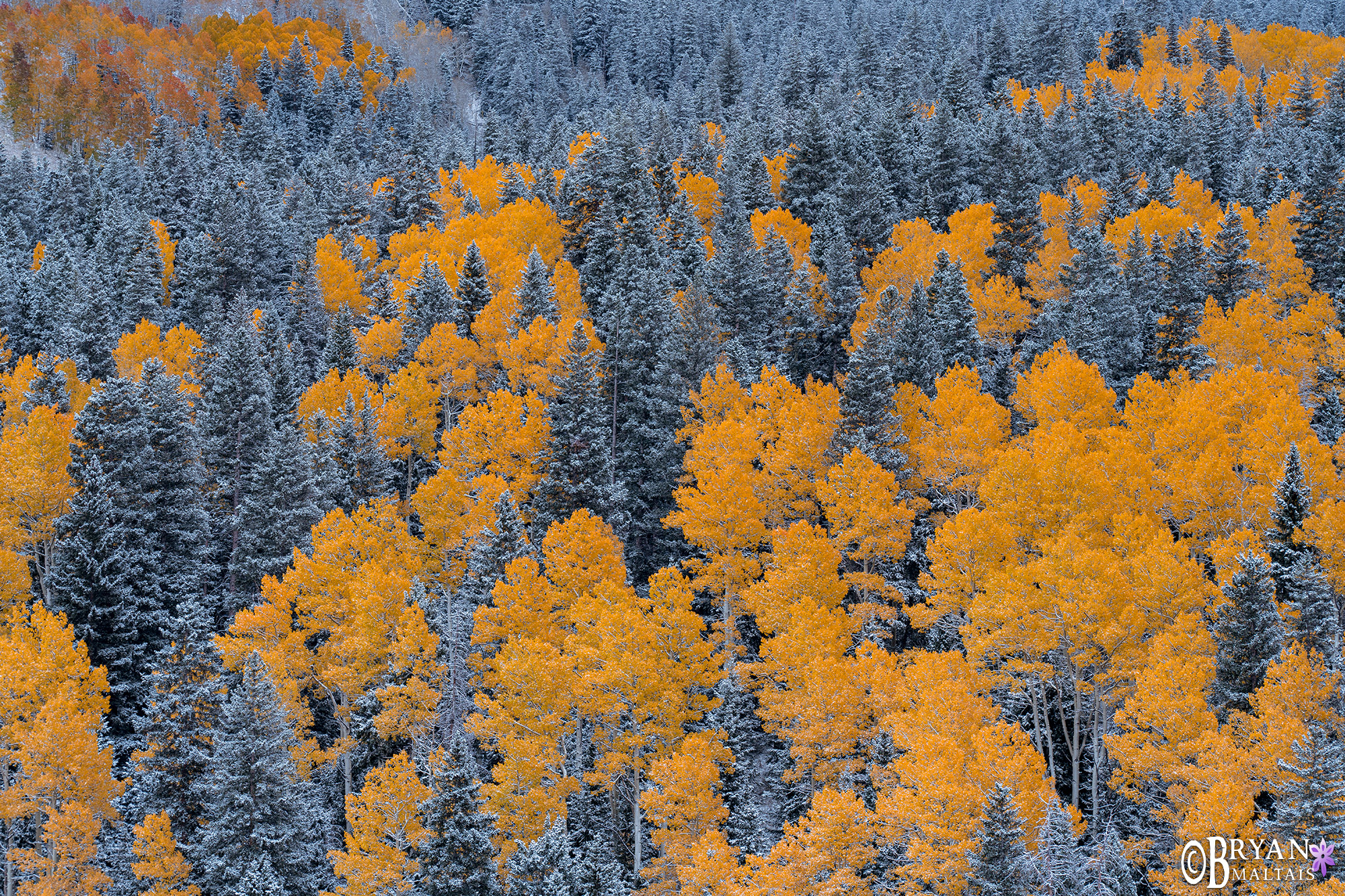
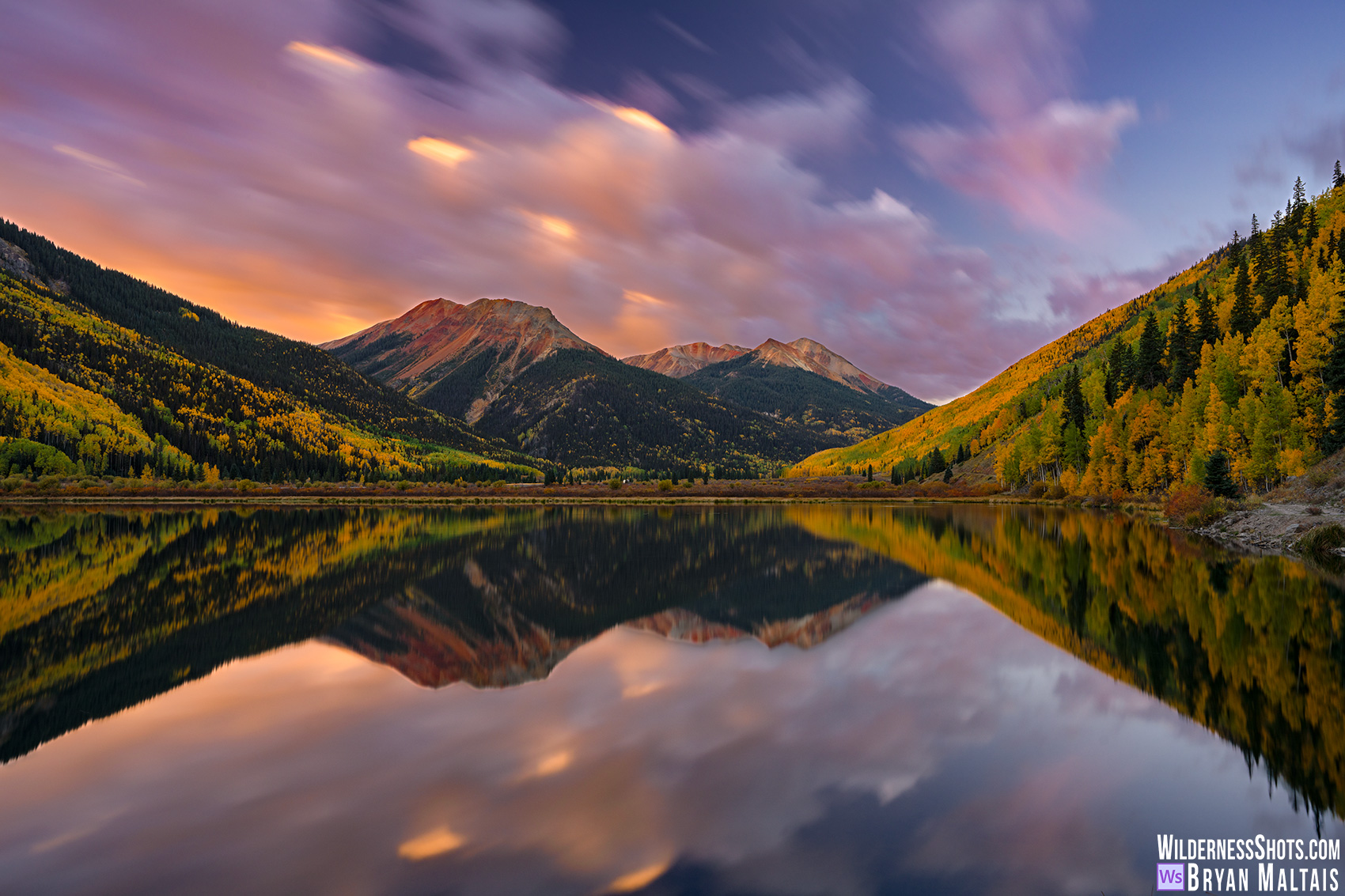 My final shoot of 2023 was the annual winter gathering of Sandhill Cranes and Snow Geese around Bosque del Apache, NM. This was an exciting year because I encountered plentiful birds, met a lot of new friends and had great shooting weather. Thousands of Sandhill Cranes and Snow Geese spend November to February along through Rio Grande River around Socorro, NM. They’re attracted by fields of corn grown for them, and shelter provided by flooded fields.
My final shoot of 2023 was the annual winter gathering of Sandhill Cranes and Snow Geese around Bosque del Apache, NM. This was an exciting year because I encountered plentiful birds, met a lot of new friends and had great shooting weather. Thousands of Sandhill Cranes and Snow Geese spend November to February along through Rio Grande River around Socorro, NM. They’re attracted by fields of corn grown for them, and shelter provided by flooded fields.